
If you prefer reading in PDF or paper format, you can download our brochure here. Or simply continue reading afterwards.
100 pages


Dear reader,
Successful B2B E-Commerce strategies are interdisciplinary ventures: It requires participants from the entire company in order to make profitable use of the advantages of digitization - and an E-Commerce platform that also takes this overarching character into account. E-Commerce is as multifaceted as your company. This applies both online and offline: The key to success lies in differentiation from the competition. For this reason, we develop a tailor-made solution for you that makes the individual strengths of your company tangible and tangible - on the desktop as well as on tablets and smartphones.
B2B & B2C E-Commerce solutions from ICONPARC are sustainable and successful! Using the example of Karl Gröner GmbH from Ulm, I will show you exactly what E-Commerce means in a B2B context.
I chose this example because we advised Mr Gröner from the very beginning on the development of the B2B E-Commerce solution. ICONPARC designed and built the Gröner B2B E-Commerce Platform: It has been in operation since 2002 and - like all our platforms - is technologically up-to-date at all times. The sustained success of the medium-sized family business Gröner shows that it pays to invest in digitization, and that is already the case for companies with annual sales of around EUR 25 million or more.
My special thanks go to Bernd Gröner and Dr. Eberhard Gröner for the trust they have placed in us for 20 years, as well as to Mrs. Lienhart for her outstanding commitment to the maintenance of the Gröner B2B E-Commerce platform.
I hope you enjoy reading all about our B2B E-Commerce Solution Digital sales channels for new markets & leads. I am pleased about your interest and any form of feedback: Please call me at +49 89 15900643 or write to me at consulting@iconparc.de.
Until then I remain with warm greetings from Munich

Antoine Levy
Dipl.-Ing. // CEO & Owner
Since the distinction between e-business and e-commerce often seems unclear, we will start with the definitions:
Excerpt from Wikipedia on the term e-commerce
"Electronic commerce, also Internet commerce, online commerce or e-commerce, refers to purchasing and sales processes via the Internet. [...] In electronic commerce, a direct business relationship between suppliers and customers is transacted through data transmission. In the broader sense, electronic commerce includes any type of business transaction in which Internet service providers - including those that are not commercial enterprises - and Internet consumers use electronic communication technologies as transaction partners in the initiation, agreement or provision of services".
Excerpt from Wikipedia on the term E-Business
"[...] Accordingly, e-business means the integrated execution of all automatable business processes of a company with the help of information and communication technology." This definition shows that e-business has an effect on transaction costs through the integration of business processes on the one hand and on throughput time and transmission costs through automation on the other. However, since integration initially takes place on the organizational side and this can then be automated with the help of ICT technologies, as far as technically feasible, a successful implementation of e-business is tied to organizational adjustments, such as process, task and data integration. Accordingly, e-business can generate the potential for success, but it can only be called up through the restructuring of organizational processes. […]“
E-Commerce is a subset of
What distinguishes B2B E-Commerce from its B2C counterpart?
| B2C E-Commerce | B2B E-Commerce | |
| Registrierung | freiwillig | zwingend, samt Prüfungsprozess |
| Kunde | Privatperson | Firma mit Ansprechpartnern, zum Teil > 100 |
| Login | freiwillig | zwingend |
| Fokus auf | Brand-Experience, Umsatz | Leads, Umsatz |
| Entscheider | Einzelperson | Gruppe |
| OCI | nein | Anbindung an ERP-Systeme des Kunden |
| EDI | nein | Anbindung an Beschaffunsglösungen der Kunden |
| Kundenbeziehung | kurzfristig | nachhaltig und langfristig |
| Kundenziele | günstigster Preis | Effizienzgewinnung |
| Verkaufszyklus | einfach und schnell | komplex und langwierig |
| Kataloge | für alle identisch | kunden-individuelle Sortimente |
| Preisgestaltung | für alle identisch | kundenindividuell |
| Preisermittlung | keine | Ad-Hoc Ermittlung aus dem ERP |
| Verfügbarkeiten | ja oder nein | Echtzeit-Ermittlung: Wann sind welche Mengen wo verfügbar |
| Lieferzeiten | für alle identisch | kundenindividuell |
| Sammelwarenkörbe | nein | ja |
| Rechnungs- und Lieferadressen | wenige, meist nur eine | Teilweise > 100 Lieferadressen je Kunde |
| Freigabeprozesse | nein | ja |
| Kommissionierung | nein | ja |
| Bestellmenge | < 3 Bestellpositionen | > 100 Bestellpositionen |
| Versandkosten | einfache Berechnung | Berechnungen bzw. individuelle Konditionen |
| Zahlunsgziele | für alle gleich | individuelle Vereinbarungen |
| Angebote | für alle identisch | kundenindividuell |
| Aktionen | für alle identisch | Kundengruppen spezifisch |
| Zuordnung von Vertriebsperson zu Ansprechpartner | nein | ja |
|
Schnittstellen | ERP (einfach) | ERP (komplex), PIM und CRM |
| Kunden-spezifisch konfigurierbare Auswertungen | nein | ja |
| Integration von CRM | nein | ja |
| Newsletter | meist identisch | kundenindividuelle Sortimente, Aktionen und Preise, Kundengruppen segmentiert |

It's simple. Almost nothing.
The majority of B2B E-Commerce processes, interfaces, data processing and administration options are located in BACKEND, which is however not accessible to customers - and the curious. The true complexity of a B2B solution is therefore at best partially visible in FRONTEND. This does not make the selection of the right partner any easier.
That's why we also show you our BACKEND systems in demos: Here it becomes clear how complex a E-Commerce B2B solution is.
Products and many services are now so interchangeable that, in practice, it is often the price that decides whether a contract is awarded or not. But offering at the lowest price is not a winning strategy in the long run - at least not for the majority of suppliers. There is a promising strategic way out: In order to gain substantial new customers - and also to optimize the loyalty of existing customers - a broad field of activity is opening up in the area of digital services & B2B E-Commerce plattforms to differentiate competitors. In the 21st century, it is primarily digitization competence that determines the competitiveness of companies!
All the more surprising, then, is a widespread attitude that can be summed up in this way:
Why digitalize?
I can see that my competitors are not any further along either!
Not at all!
What is visible on the Internet is only the FRONTEND, the tip of the iceberg. In addition, B2B e-Commerceportals are usually closed off and therefore not accessible without login and password. This means that the type, scope and level of automation and processes running in FRONTEND or in the background - so-called BACKEND - cannot be assessed. B2B APPs are also located in a protected area, so that you are not aware of the progress of your competitors in digitisation. And this is how markets are distributed, quietly and quietly.
Without you noticing it.
And if ... then it is often too late.
Where companies used to dominate the market and customers put products in front of their noses, digitalisation has turned the tide in a disruptive way: The digital natives, who are increasingly pushing their way into business life, are almost all online and expect ...
Me, everything and now!
If you don't adjust to them, you will lose the connection - and these customers.
We are of the opinion that in the long term, customers can be bound not by digital presence, but by digital processes.
For us and our customers, digitization is not an end in itself, but a powerful tool for marketing and sales - with measurable results such as sales. Digitisation using a software product is a tactical approach. Digitisation by means of a solution, on the other hand, allows many tactical measures to be interlinked with an overarching strategy. Solutions from ICONPARC stand for a comprehensively integrated approach with a strategic character. All derived measures flow into the performance characteristics of the respective solution at the operational level - and thus contribute to its success.
We develop solutions to complex problems. Such interdisciplinary projects can only be realized in a team or with a combination of extraordinary talents. ICONPARC brings together the talents and experience of more than 20 software developers, most of whom have been with us for more than 10 years - some for more than 15 years.
According to Wikipedia, the constitutive characteristics of solutions are
- Combination: A customer solution consists of several, different and related services and products, or services and services. This combination gives a solution a high degree of problem-solving potential, i.e. it can solve a complex customer problem. A single product or service is not a solution because these isolated services cannot solve a complex problem.
- Integration: In a solution, the products and services are coordinated so that they are technically and functionally combined to form a whole. This is called internal operational integration. In addition, a solution is geared to the circumstances and requirements of the customer company. This circumstance is called external integration.
- Individualization: A solution is adapted to the requirements of an individual customer. Individualization primarily concerns the creation, selection and composition of the service components, but also, for example, price fixing.
On the following pages we present the development and performance features of the B2B E-Business solution developed for the medium-sized company Gröner: The FRONTEND already shows how highly individualized product-specific representations and operating systems were created by means of customization. With an off-the-shelf product this would only be possible to a very limited extent - at the expense of customer acceptance.
FACTS & FIGURES
Figures, data, facts about Karl Gröner GmbH

Founding year
Annual turnover
Products
Staff members
Going live
Online turnover per year
Karl Gröner GmbH is a specialist dealer for advertising technology with 110 employees. The family business from Ulm can look back on more than 70 years of history. The extensive product range includes around 120,000 articles from the fields of films, screen printing, advertising textiles and decorative systems as well as digital services and system solutions for advertising technology.
Dr. Eberhard & Bernd Gröner
Managing Directors of Karl Gröner GmbH
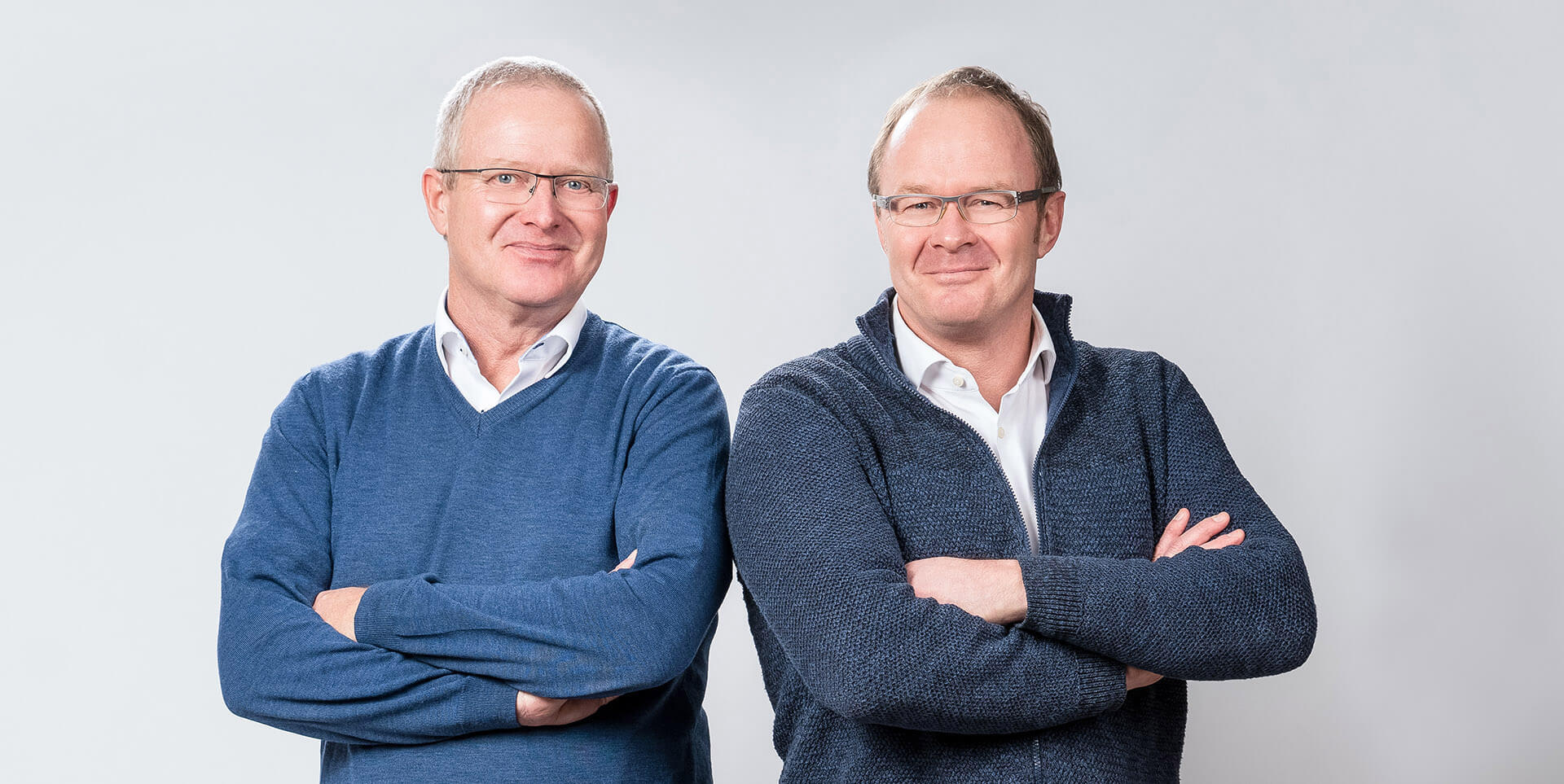
"Without our B2B E-Commerce platform, the wholesale business in our industry would no longer be affordable today. The independent, flexible adaptation of the product ranges, an extremely high-performance price and availability check based on individual customer conditions and not least the all-encompassing product information, which has contributed to the high acceptance of the platform, confirm our opinion, even after more than 20 years of live operation, that ICONPARC is the right partner in the jungle of E-Commerce providers and developers".
PHASE I - CONCEPTION
Successful solutions succeed thanks to 24 years of experience - always measurable, especially based on online sales.

We brought management, sales and marketing together at one table. In four workshops, we worked together to develop a promising strategy. The result was a 96-page specification (requirements and functional specifications) including numerous illustrations, tables and annexes.
You will find the specifications of an exemplary B2B E-Business strategy divided into phases here ...
UX & UI Design Study
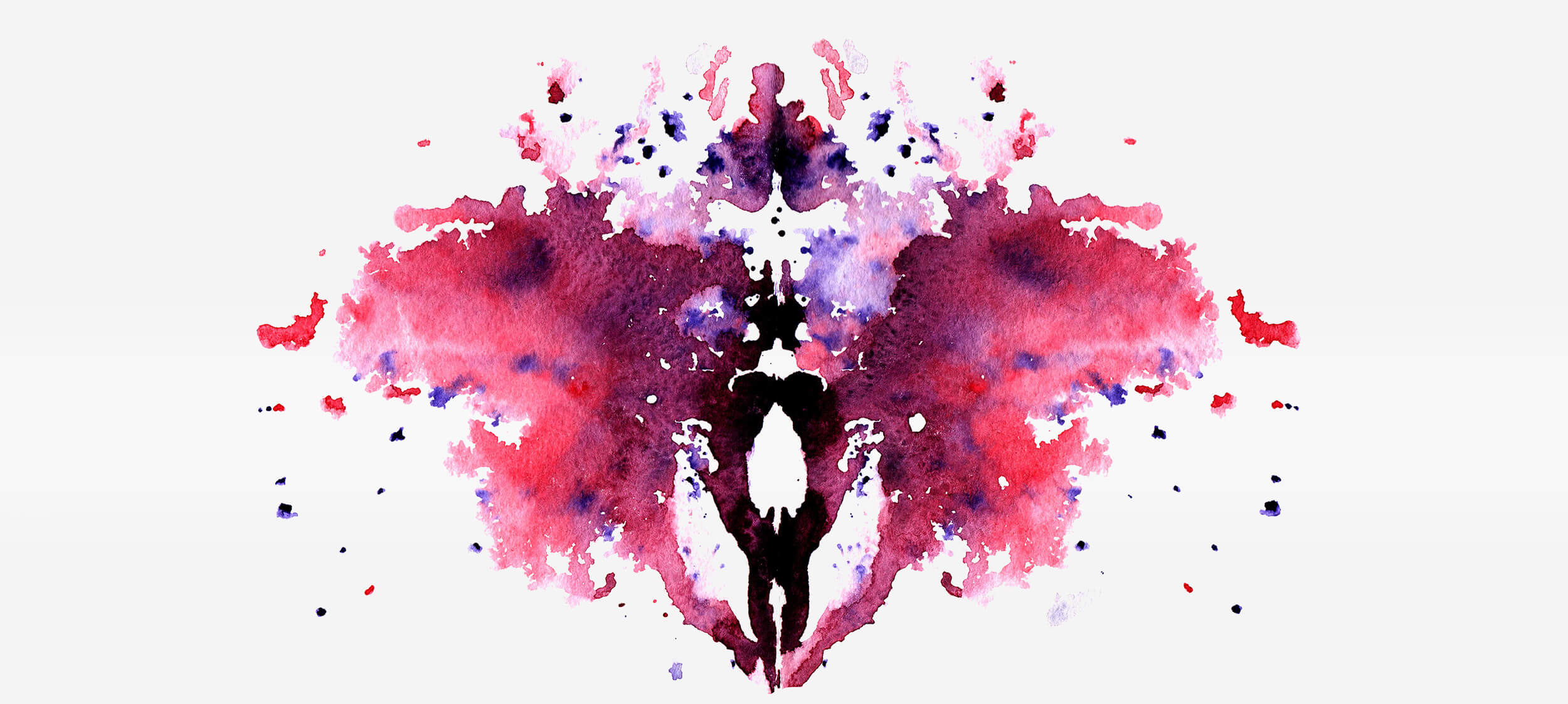
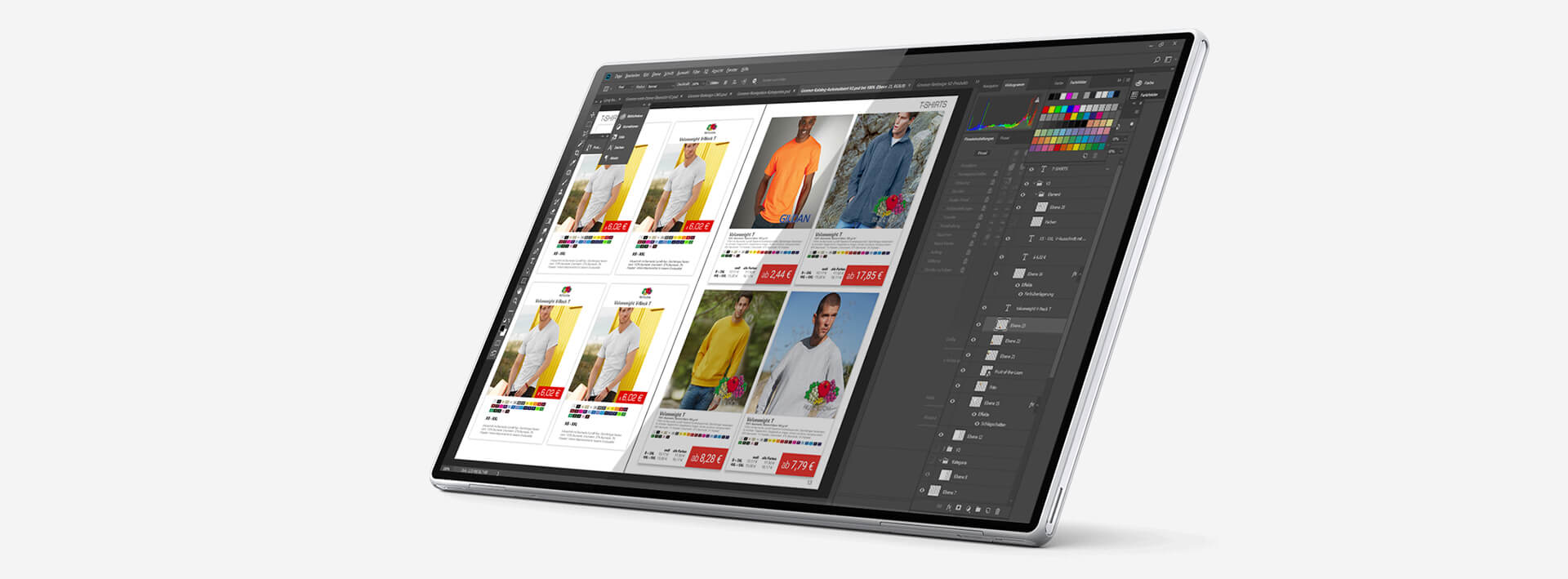
We presented various design drafts to the Gröner management, whose focus from the very beginning was to offer customers and interested parties a pleasant user experience (UX). All designs were first created in Adobe Photoshop or using the Affinity Suite. In the second step, an HTML/CSS/JS prototype was created for the desired design, which was tested on all end devices and iteratively refined.
PHASE II - CONVERSION
Afterwards the implementation with all interfaces took place within 6 months. After a two-month test phase in the testenvironment, the B2B e-Commerce solution went live.
ICONPARC E-Business Suite
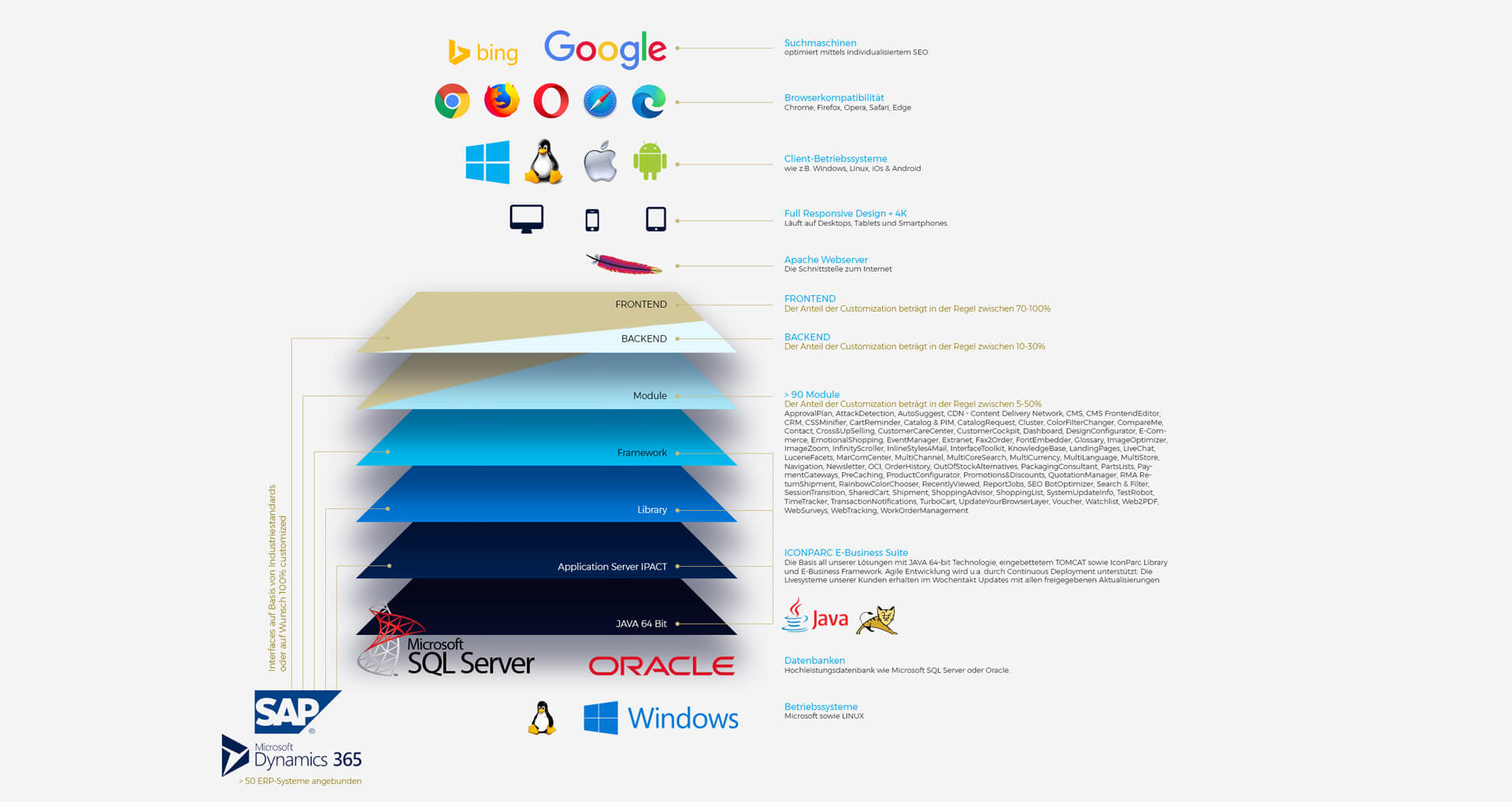
Multi-Layer Architecture
The modular ICONPARC E-Business Suite is the basis for successful B2B E-Business solutions. It is characterized by easy extensibility, flexibility and high performance. The standard framework forms the basis for all modules and is compatible with common operating systems such as Windows and Linux. The core consists of a high-performance database such as Microsoft SQL Server or Oracle, the ICONPARC Application Server (IPACT) and an extensive library that grows daily. The system owes its high performance in particular to the Java Application Server (64 bit), which together with an Apache web server forms the interface to the Internet. All applications implemented on this basis can be operated entirely via a web browser. Additional client installations are therefore no longer necessary. The library offers extensive functionalities that are available to all modules and enable their seamless integration. The modules cover a wide range of application scenarios and can be supplemented with additional modules as required. With the help of the integrated development environment, subsequent as well as individual extensions and adaptations can be implemented within a very short time. This allows your company to profit quickly from changing market conditions.
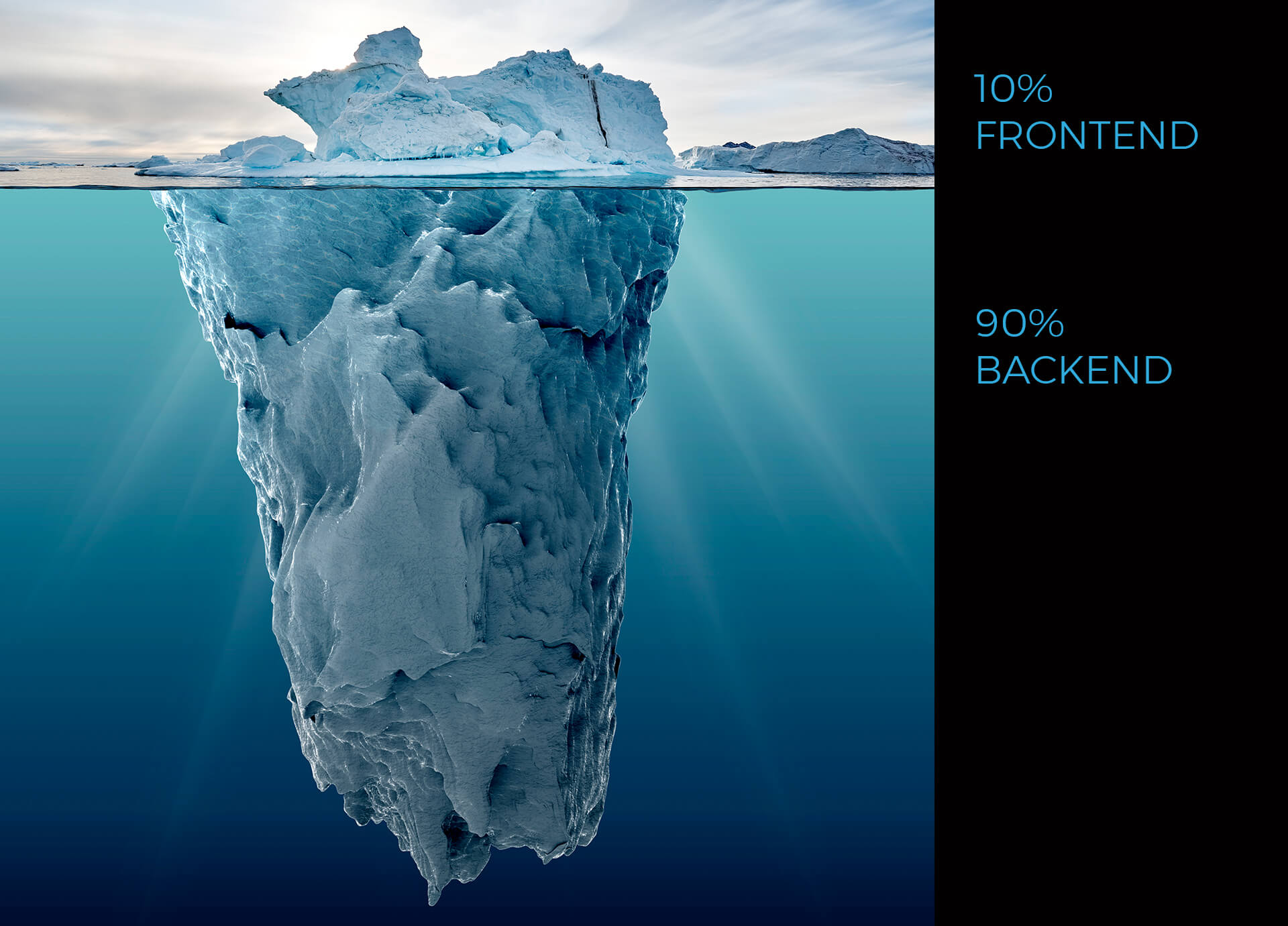
The tip of the iceberg, the
FRONTEND
The following page scenarios are available in FRONTEND. The contents of all pages, consisting of personalizable documents and contributions, are generated dynamically with every click. An intelligent caching system ensures best performance during page delivery. Guest visitors already have around 11,000 pages at their disposal at www.groener.de
- home page
- product group pages
- Search with Auto Suggest
- Hit lists with filter and Infinity Scroll
- Product pages for differently structured product types and parts lists
- Zoom function for images as layers
- Print view with specifically designed PDF page variants
- Cross and up-selling
- Recently viewed products
- offerings
- enquiries
- actions
- novelties
- brand sites
- Editorial pages in the form of documents (min. 10 templates for different purposes)
- Editorial contributions which can be personalized and placed on other pages as often as desired (min. 20 templates for different purposes)
- Shopping Cart Layer; Shopping Cart Detail Page
- Free orders via direct input or Excel upload
- Check-out process pages: Overview; Check; Transfer Order
- contact form
- Login; Registration
- Order History: Search & Order View with QuickFill Feature
- My personal data & company data, depending on authorization (new / change / delete)
- My addresses (new / change / delete)
- Password forgotten; Change password
- Subscribe / unsubscribe newsletter
- Returns Overview & Returns Details (RMA Process)
On the following pages we show you selected examples from the B2B e-Commerce solution www.groener.de, which was built exactly according to the design study...
All page scenarios are optimized for common browsers and devices.
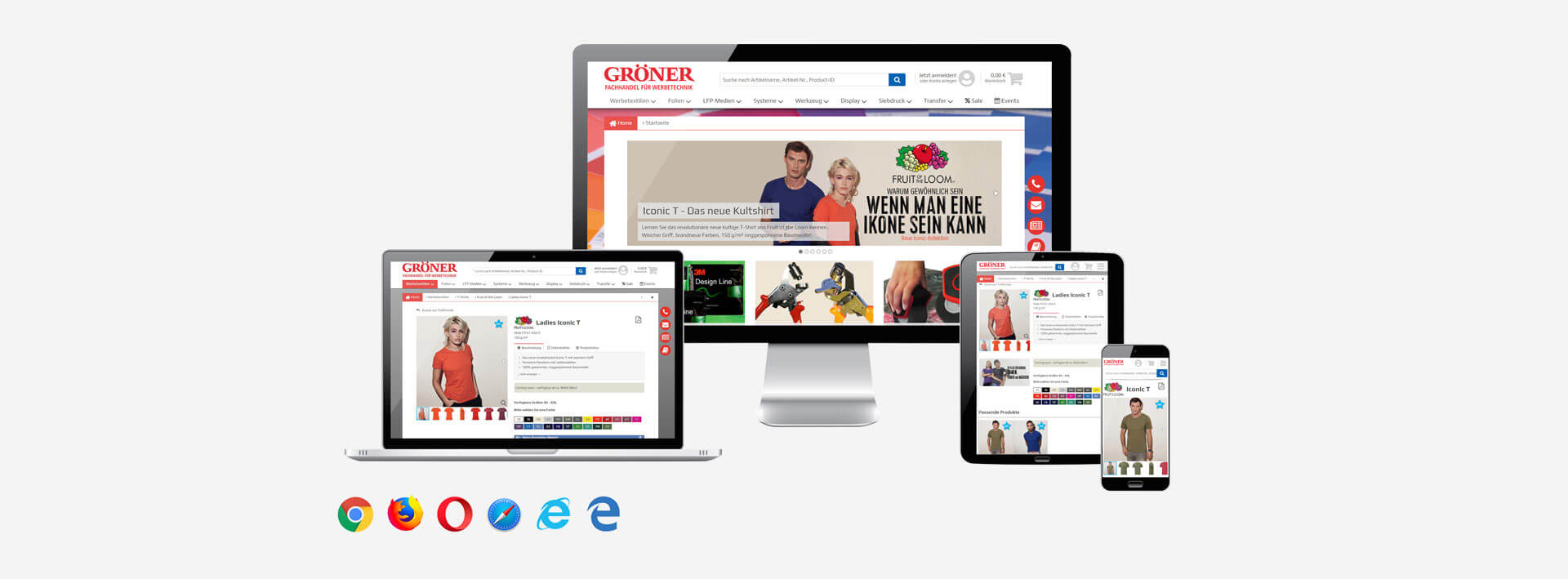
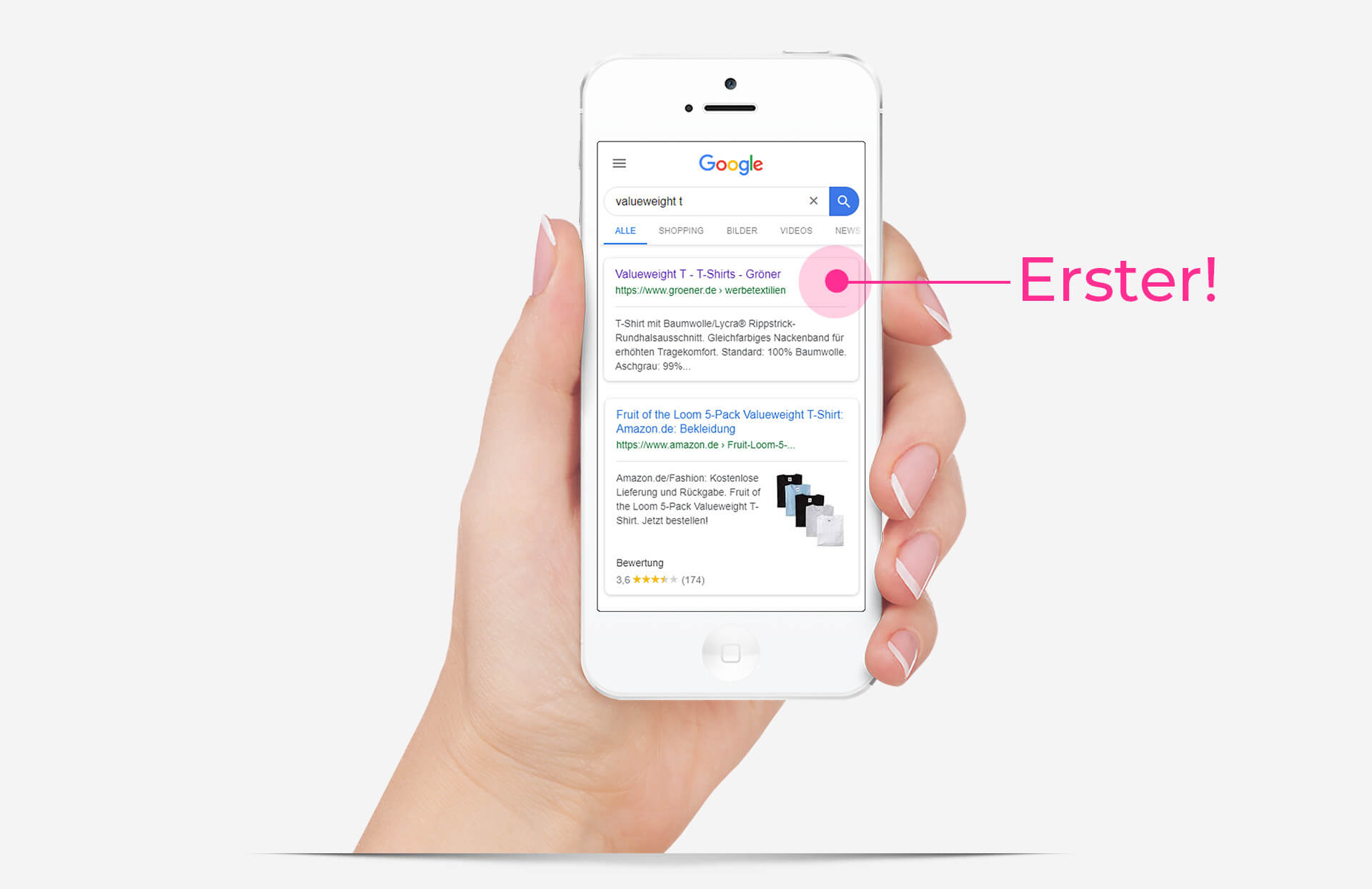
Many years of experience with optimizations for Google & Co. are rewarded with an attractive ranking.
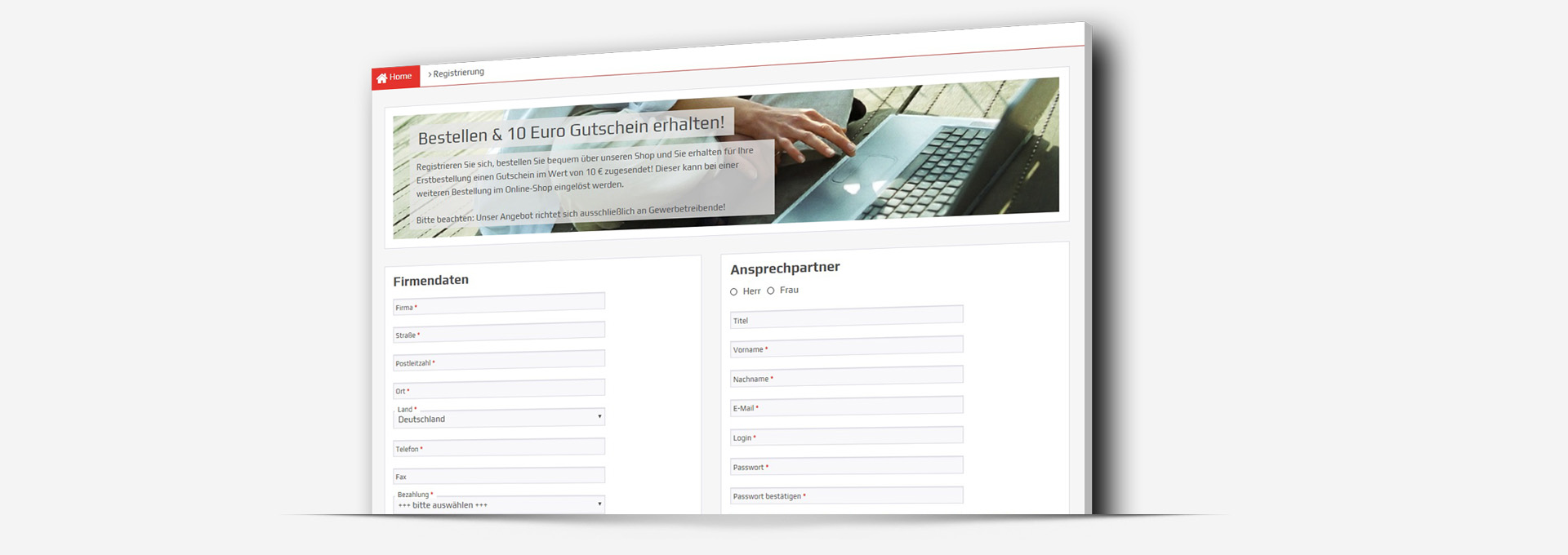
Because visitors in the B2B environment usually only see prices once they have registered, the B2B E-Business solution is also the essential tool for lead generation. A voucher for first-time buyers turns many registered interested parties directly into buyers.
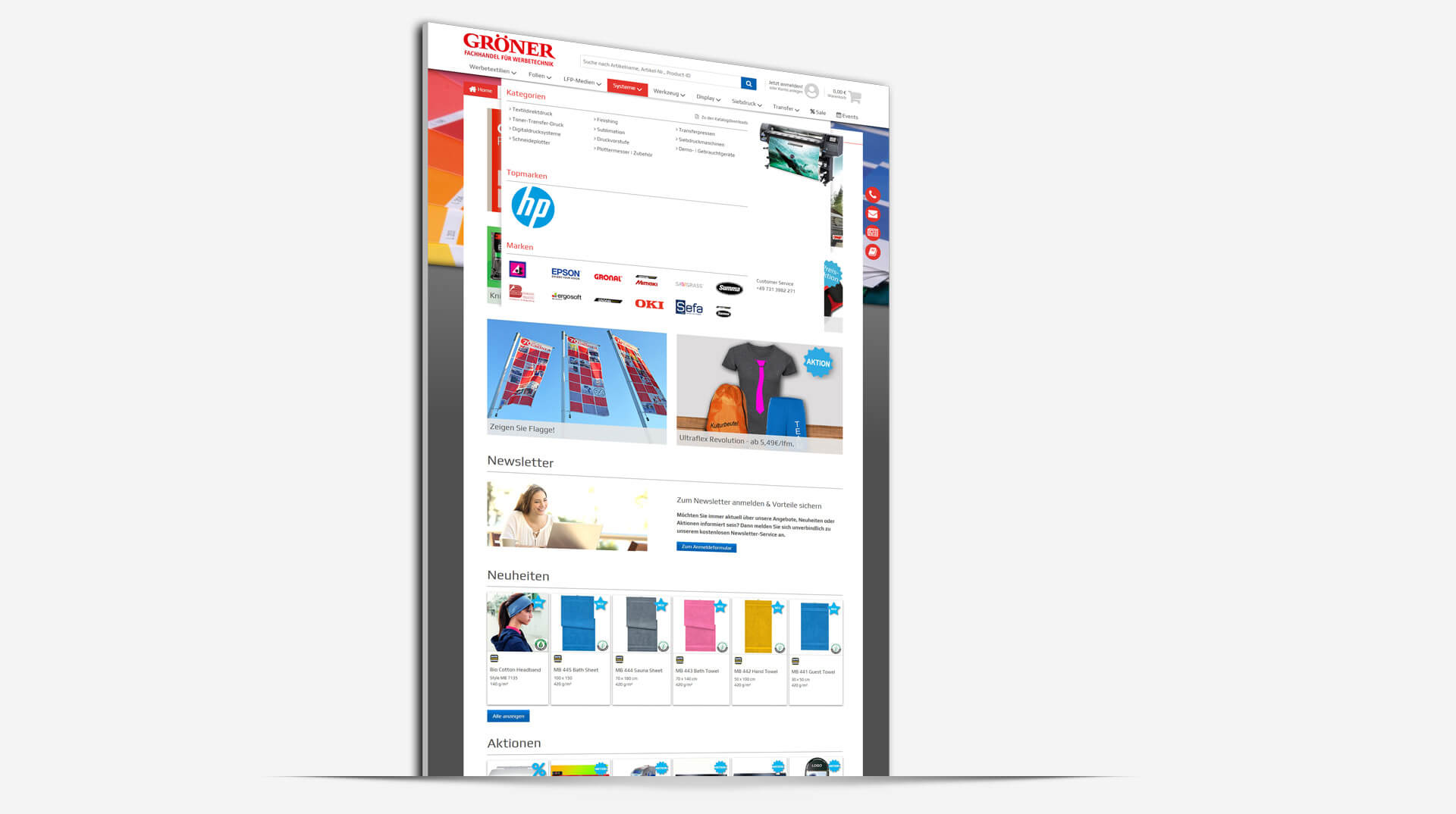
On the clearly arranged start page, editorial teasers arouse curiosity about key topics. Elements that are available on all pages are arranged in the header area (search, assortment navigation, customer account, shopping cart) or on the outside right (contact person, making contact, newsletter, catalogue downloads).
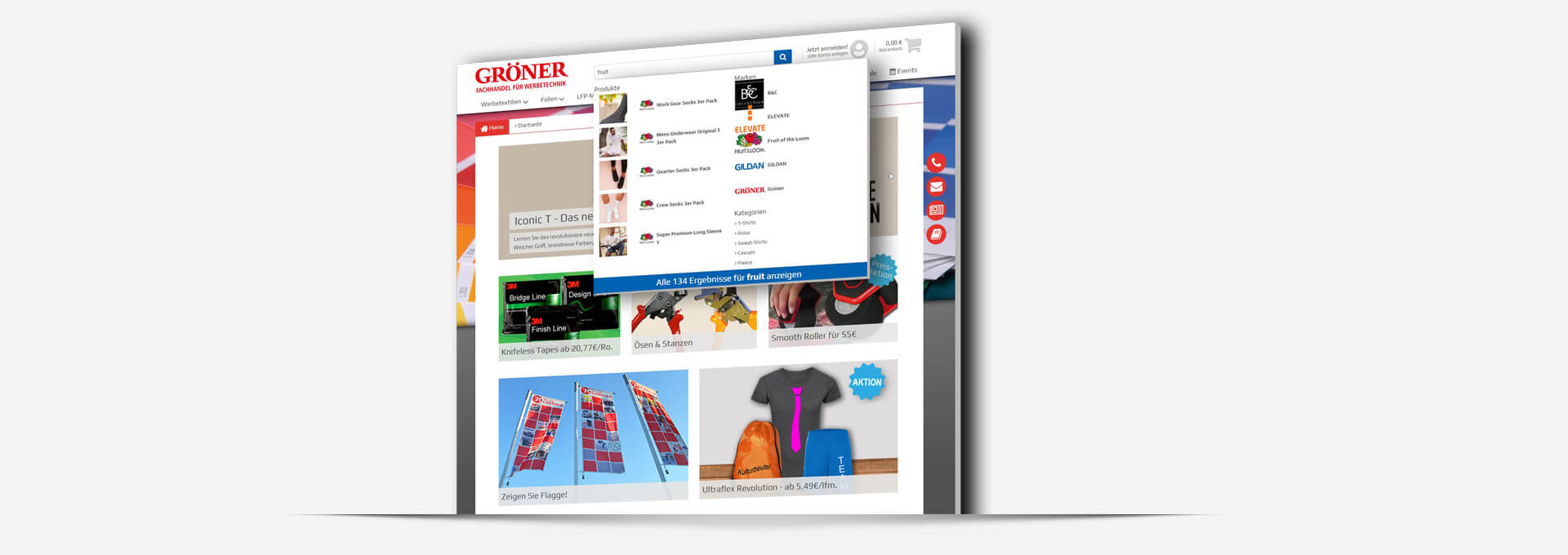
Already after typing a few characters into the centrally placed search field, suggestions for hits appear, whereby products, brands and product groups are taken into account. If the suggestions do not yet contain the searched item, one click opens the list of all hits. The page footer offers entry points for many overlapping topics (imprint, data protection, shipping costs, etc.).
The big clou: The impressive performance!
Access 120,000 articles in less than 100 ms!
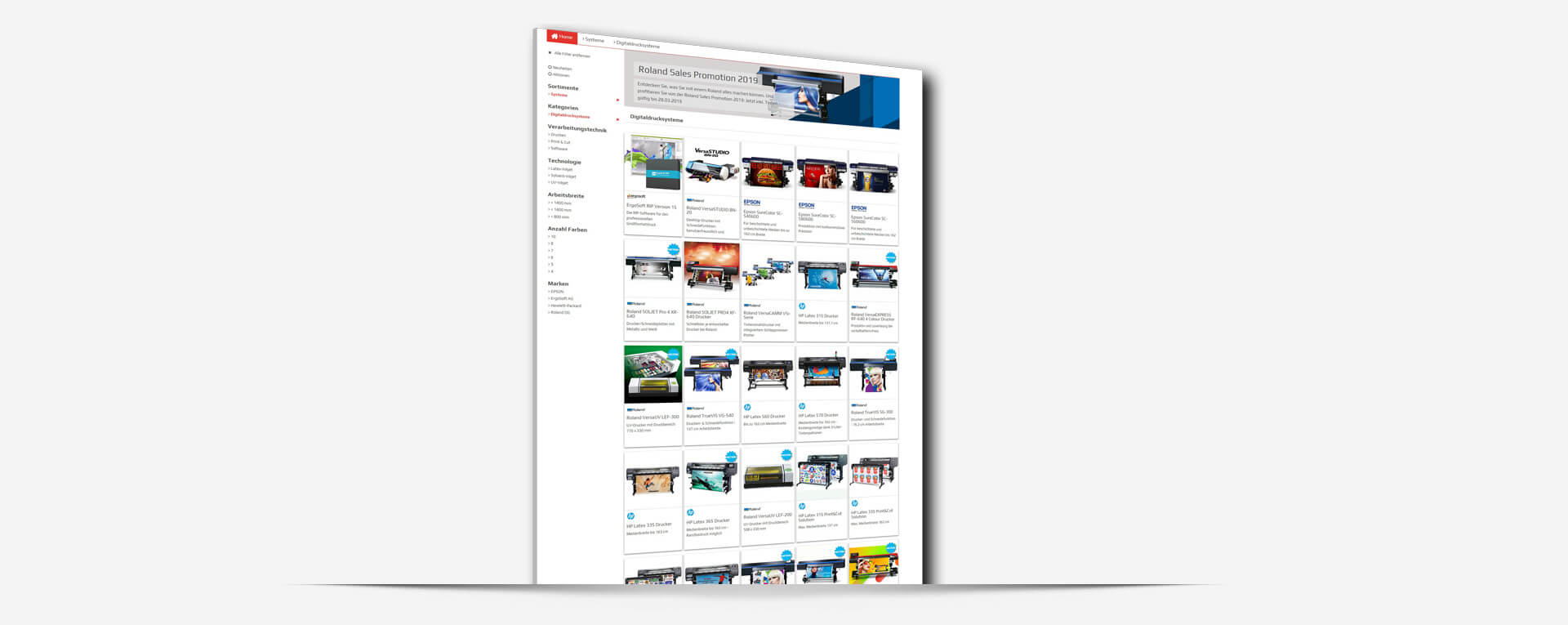
When entering via the search function, filters serve as after-search navigation - this makes it easy to restrict the hit list to the desired products. The hit list is equipped with InfinityScroll, which means that it simply reloads additional hits as soon as the visitor reaches the bottom of the page while scrolling vertically.
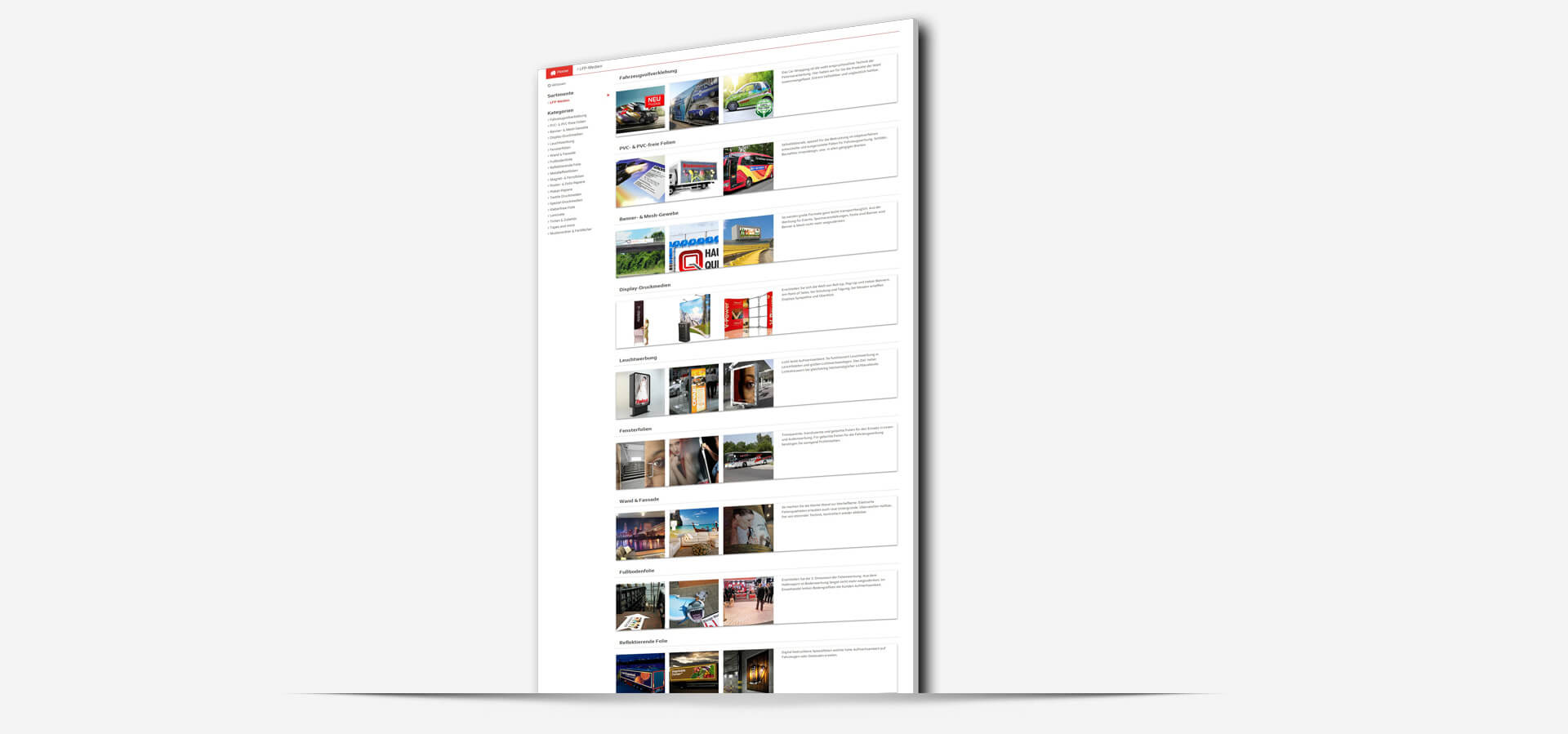
When entering via an assortment from the main navigation (in the example: "LFP media"), the overview page provided with illustrations and additional explanations invites you to browse: The visitor learns interesting facts about all subcategories of the selected assortment. After selecting a category, the corresponding (filterable) hit list appears again.
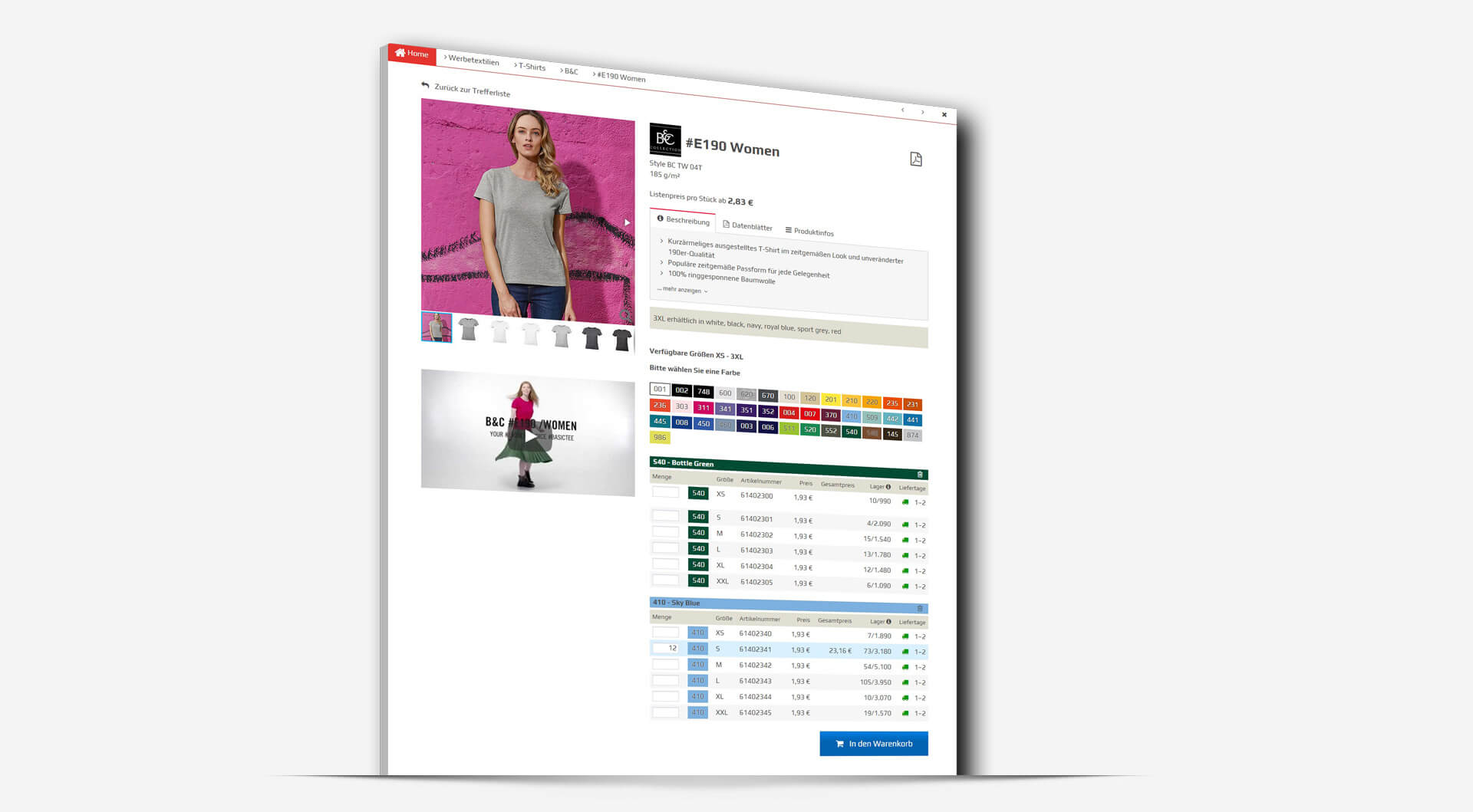
Image slider with all color variations (zoomable); description & data sheets; color selection: By clicking on a colour - without reloading the page - a form part appears with the size run; prices, stock quantities (Gröner and supplier), delivery time are determined ad hoc; transfer of all desired colour/size variants into the shopping basket in one step.
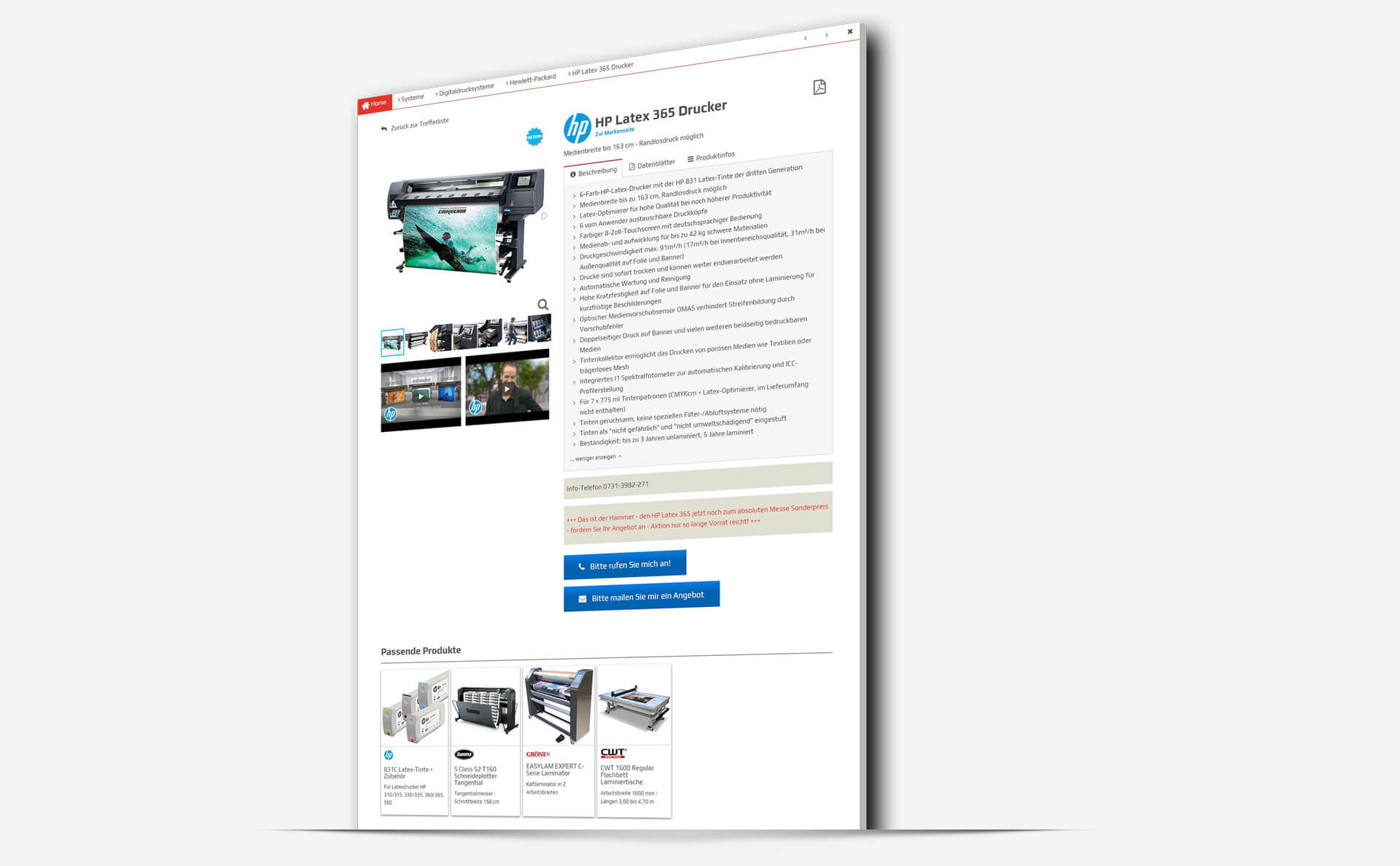
Products requiring explanation cannot be ordered directly. Instead, a simple contact to an experienced Gröner consultant is made possible; alternatively, an offer can be requested. Product alternatives are shown at the bottom of the page.
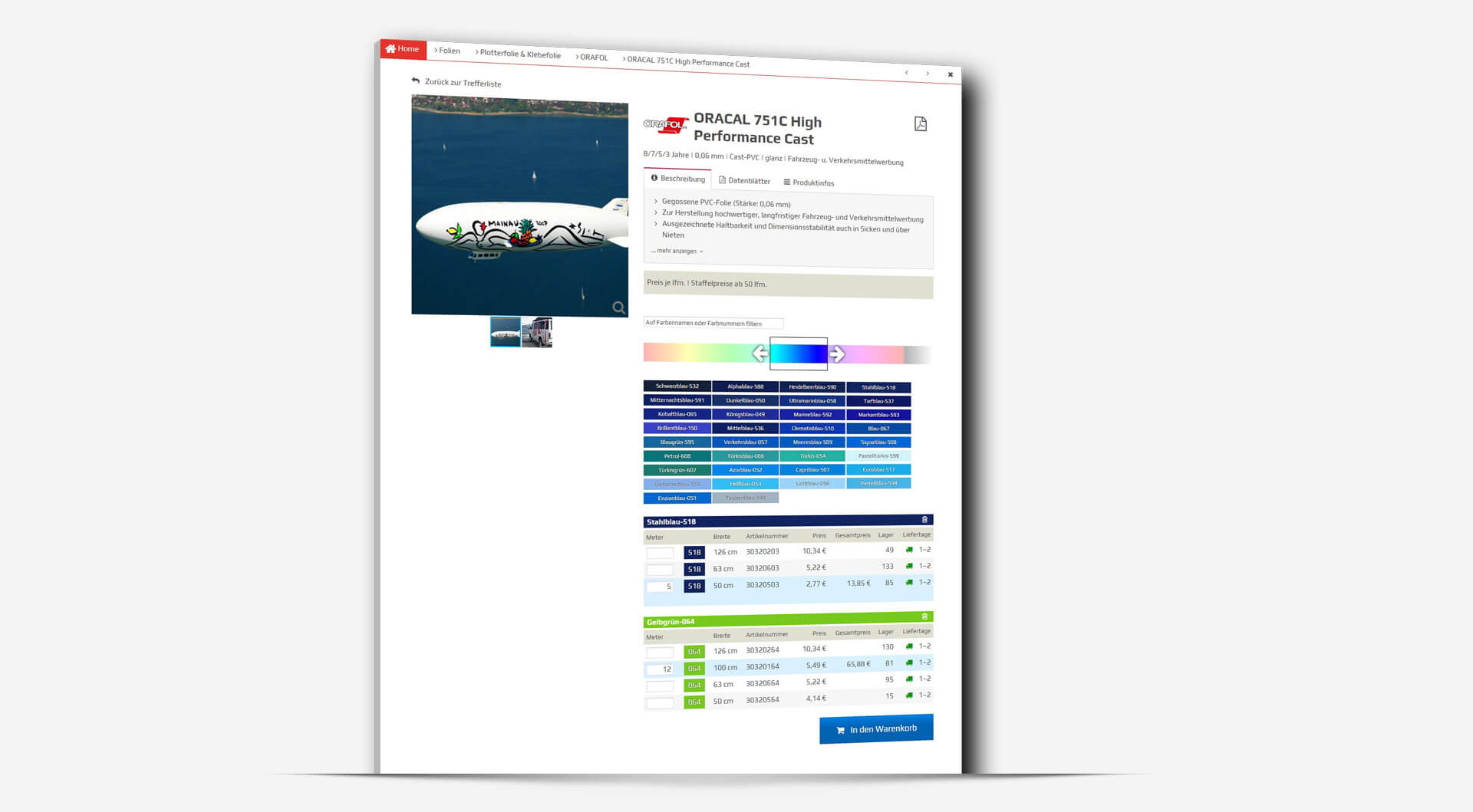
Structurally similar structure to the product side in the textile sector, but with the following deviations: Filterable colour range slider to reduce the very extensive colour selection to a manageable size; form part with different features ("width" instead of "size") and other order unit ("meter" instead of "piece").
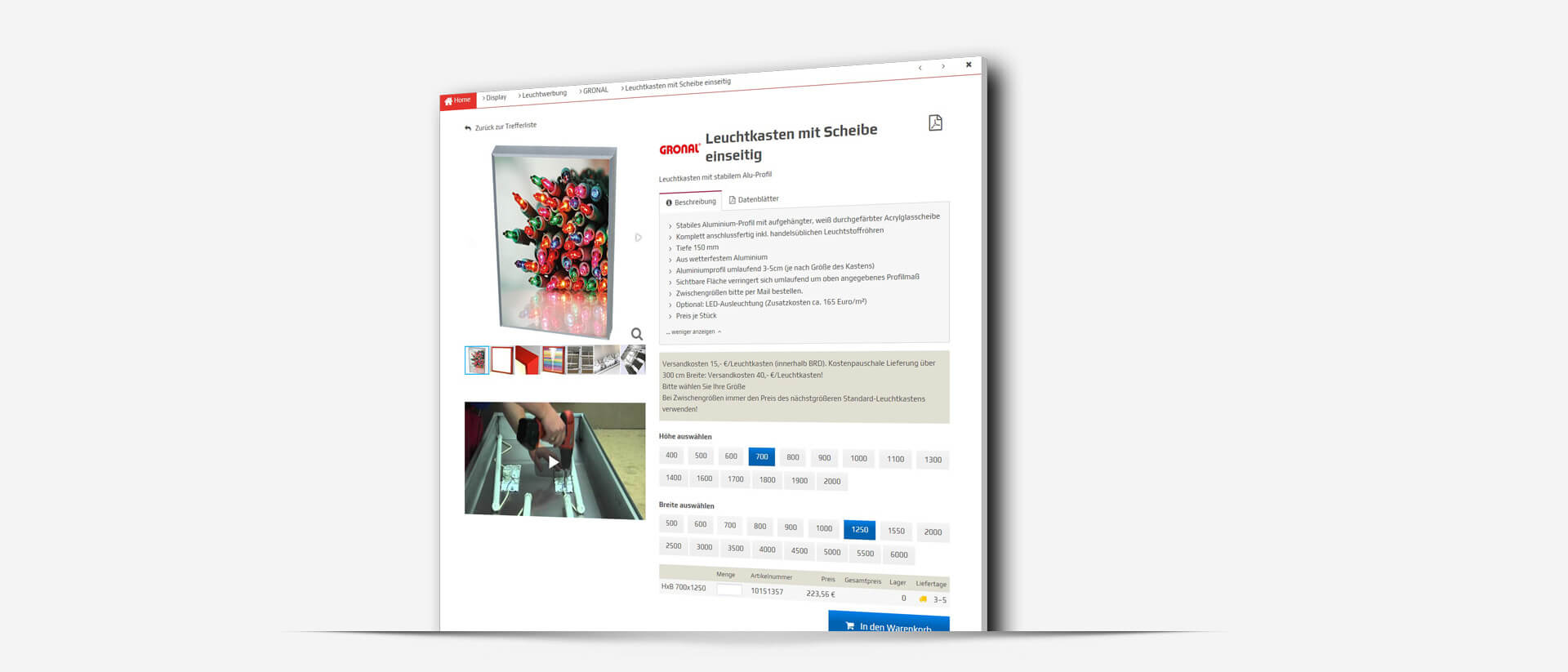
Example from the "Display" sub-range: In addition to descriptions and data sheets, explanatory videos are included; specific variant dimensions (height and width) lead to the form part after selection of the desired values; at the end of the page, product alternatives are again offered for selection.
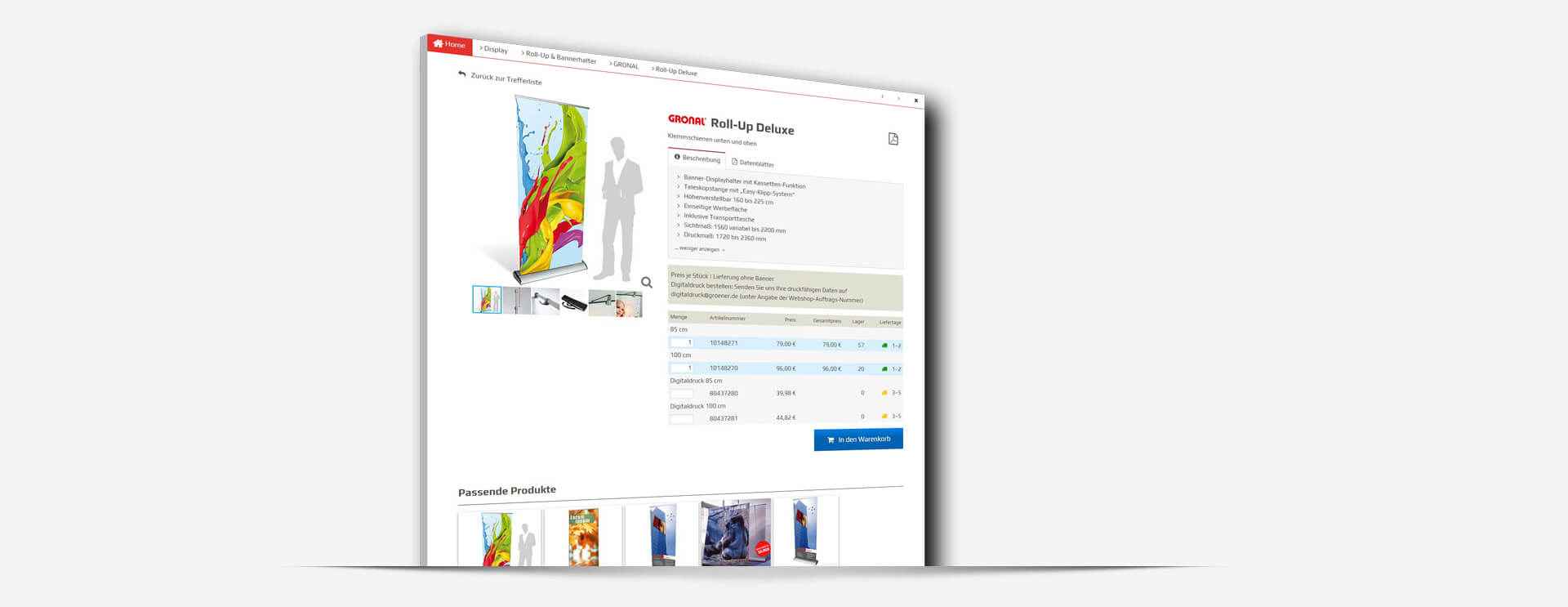
A simple order form is displayed for the articles grouped to a product, for example for the different sizes of a stand display.
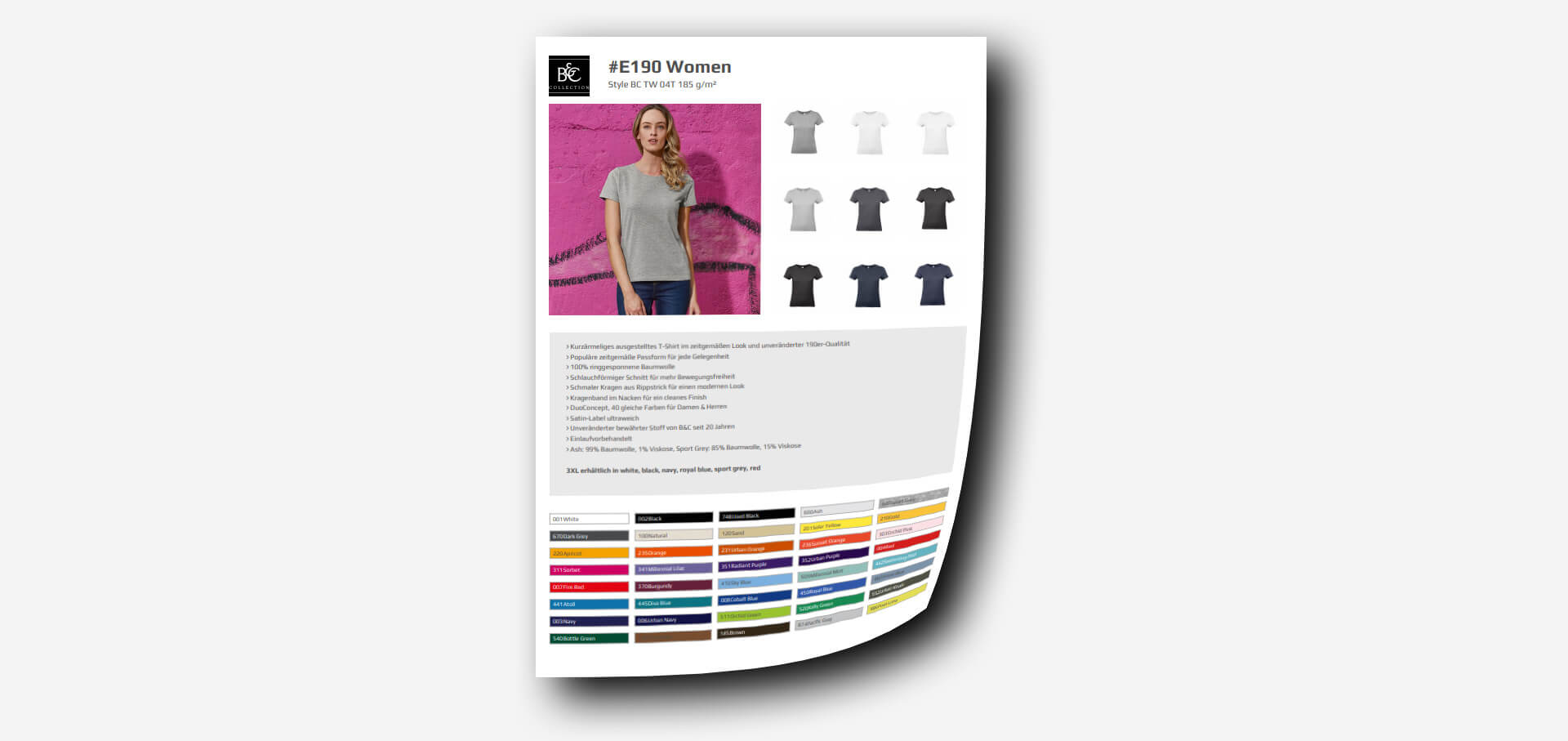
Each product page can be downloaded directly as a PDF document. The essential product information is clearly presented, so that Gröner's offer also makes a good impression offline.
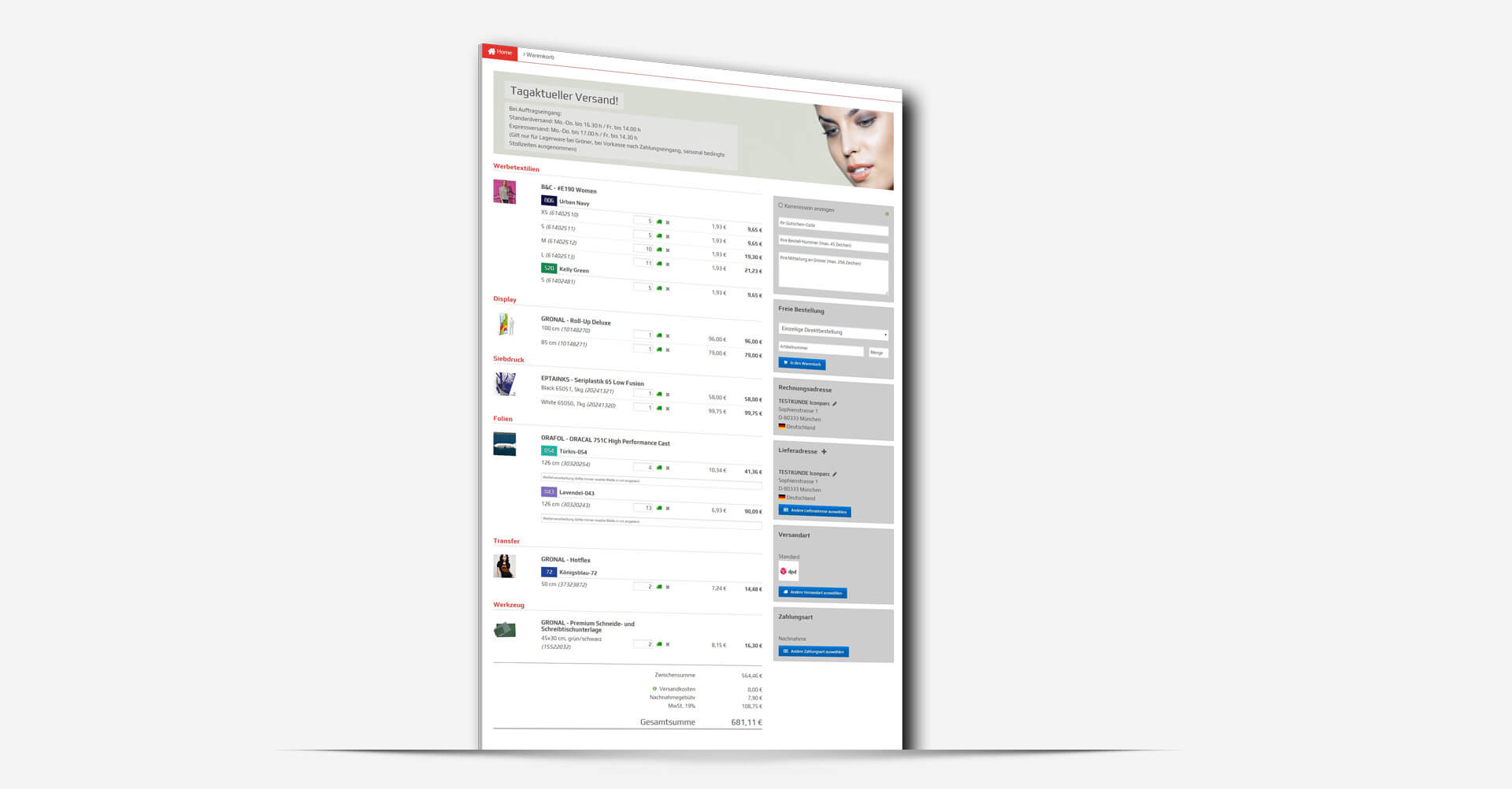
Due to the wide and deep assortment, the shopping cart view is structurally particularly demanding: For maximum clarity, the products are grouped in up to three levels - according to sub-range (e.g. "advertising textiles"), style or main product as well as first variant dimension (e.g. "colour"). All desired variants of a product can thus be seen at a glance on the B2B e-Business platform.
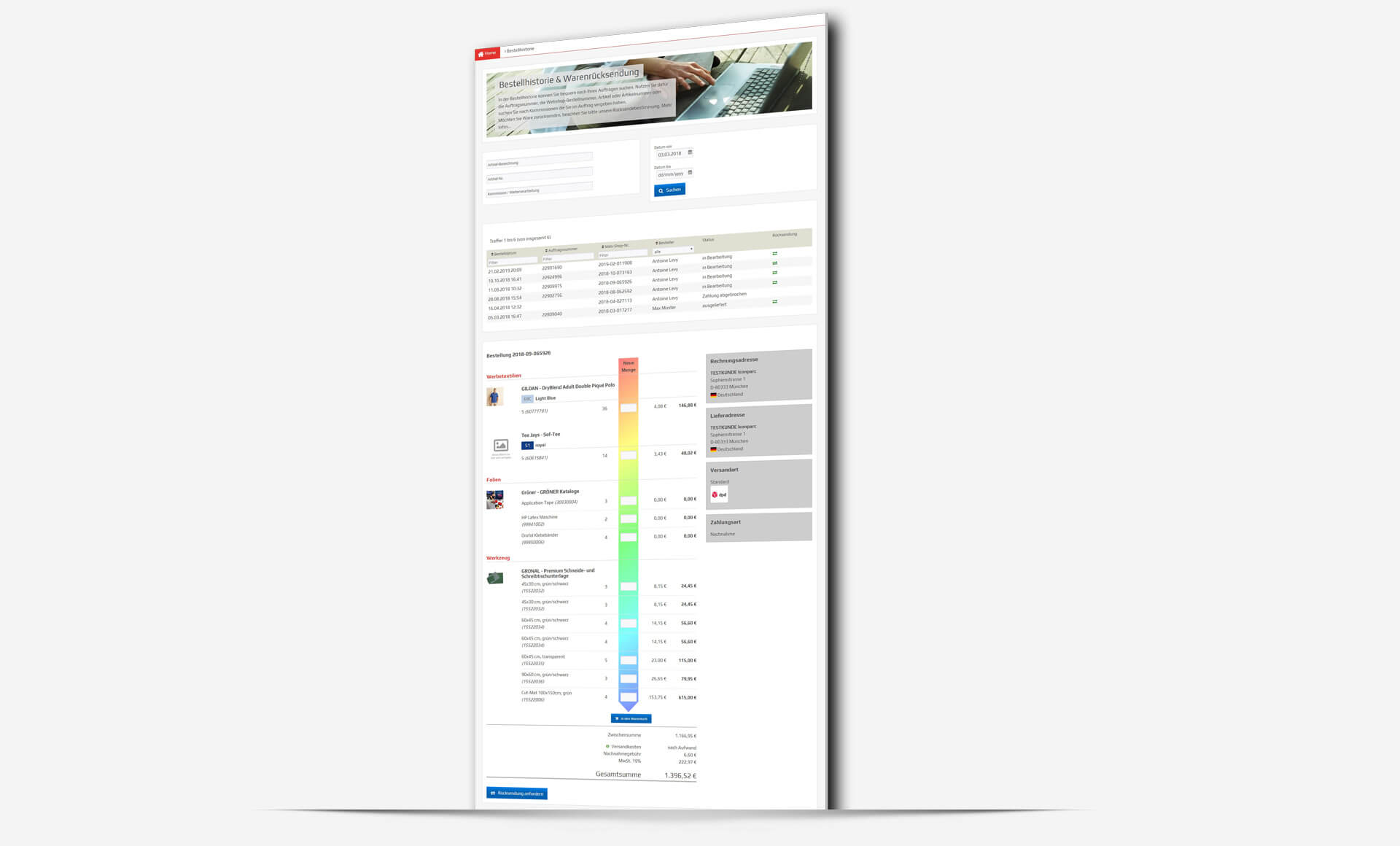
All customer orders - whether entered online or offline - are accessible at any time in the order history, which can be filtered through and filtered. This also includes status information on the progress of each order. By entering new order quantities, previously purchased items can be placed in the shopping basket again with just one click.
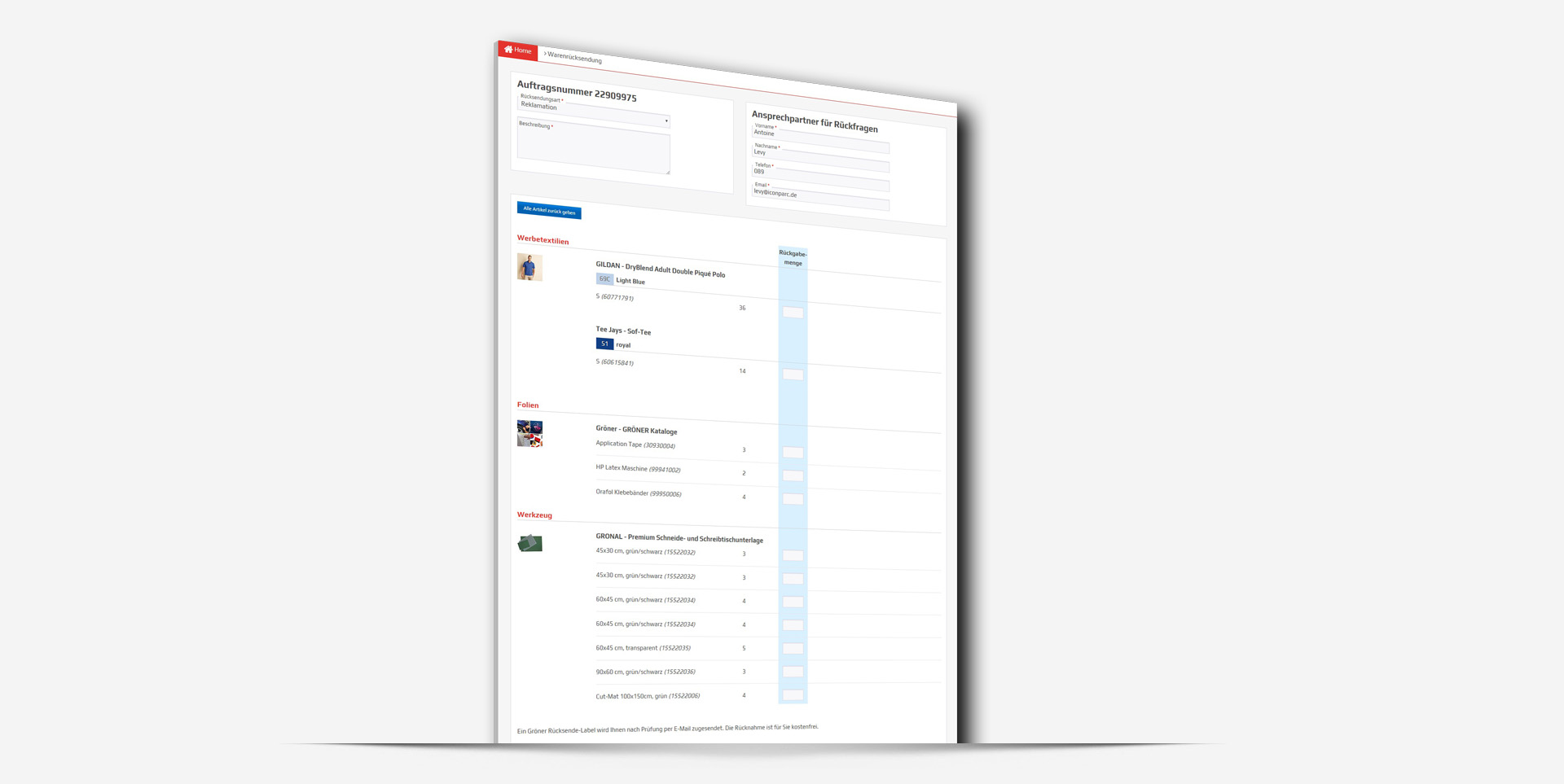
An RMA (Returned Material Authorization) process is integrated so that returns can be processed efficiently: For each delivered purchase order, you can select which item(s) and quantity(s) are to be returned - including the reason for the complaint. Gröner will then provide the necessary shipping documents so that the customer also has it easy.
Analogous to the order history, a searchable and filterable list helps the customer to keep track of his returns. For each individual case, the RMA process can be traced in all steps.
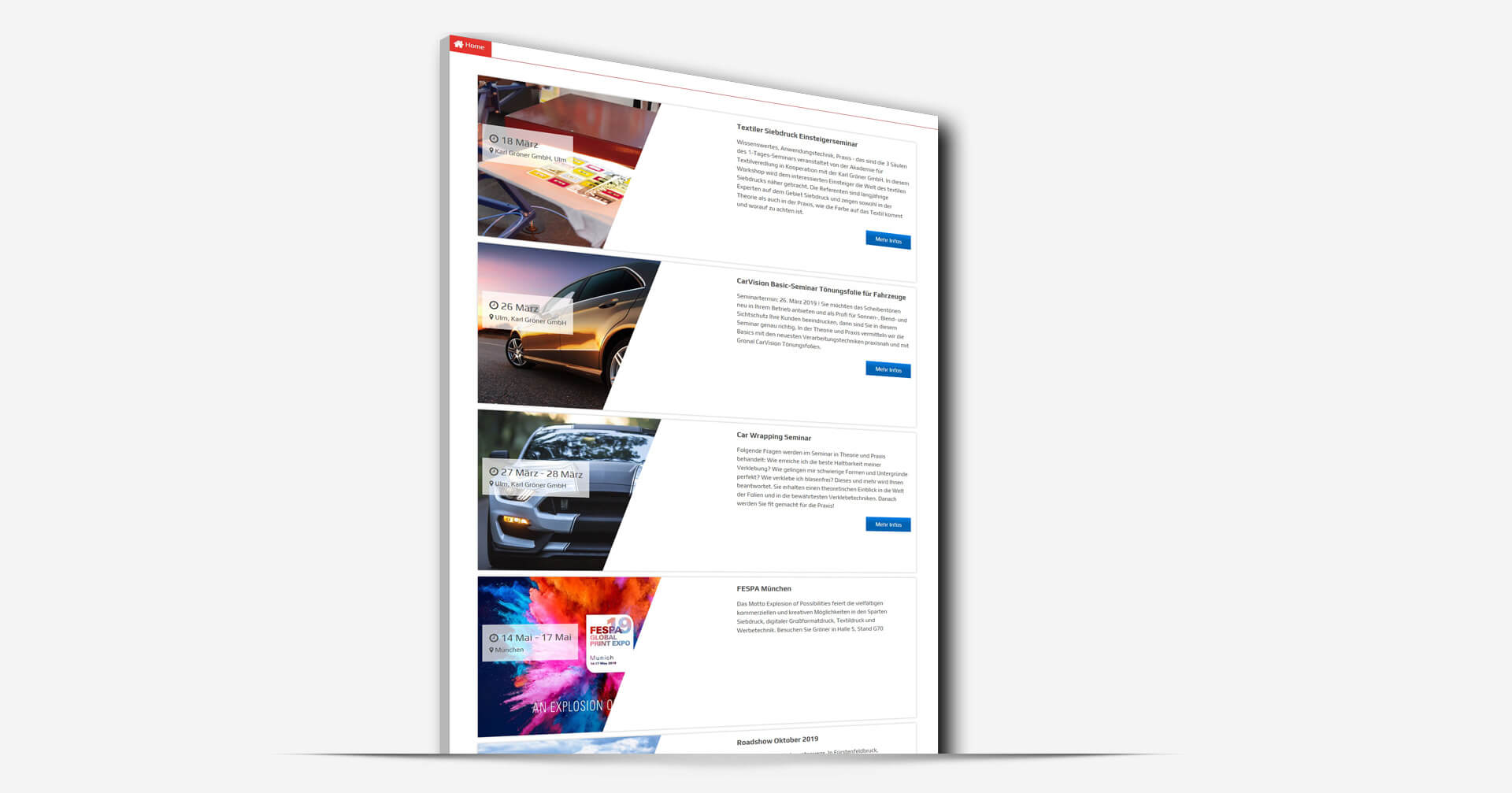
Trade fair appearances, road shows, seminars, etc. - all upcoming events are listed in chronological order and briefly presented. A detailed description can be found on a separate page under "More information". There you will also find the access to the registration ...
Registration for an event can be done conveniently online. As usual, the registration form is prefilled as far as possible after the visitor has logged in to the Gröner webshop. The confirmation of participation will be triggered via the BACKEND and sent by e-mail.
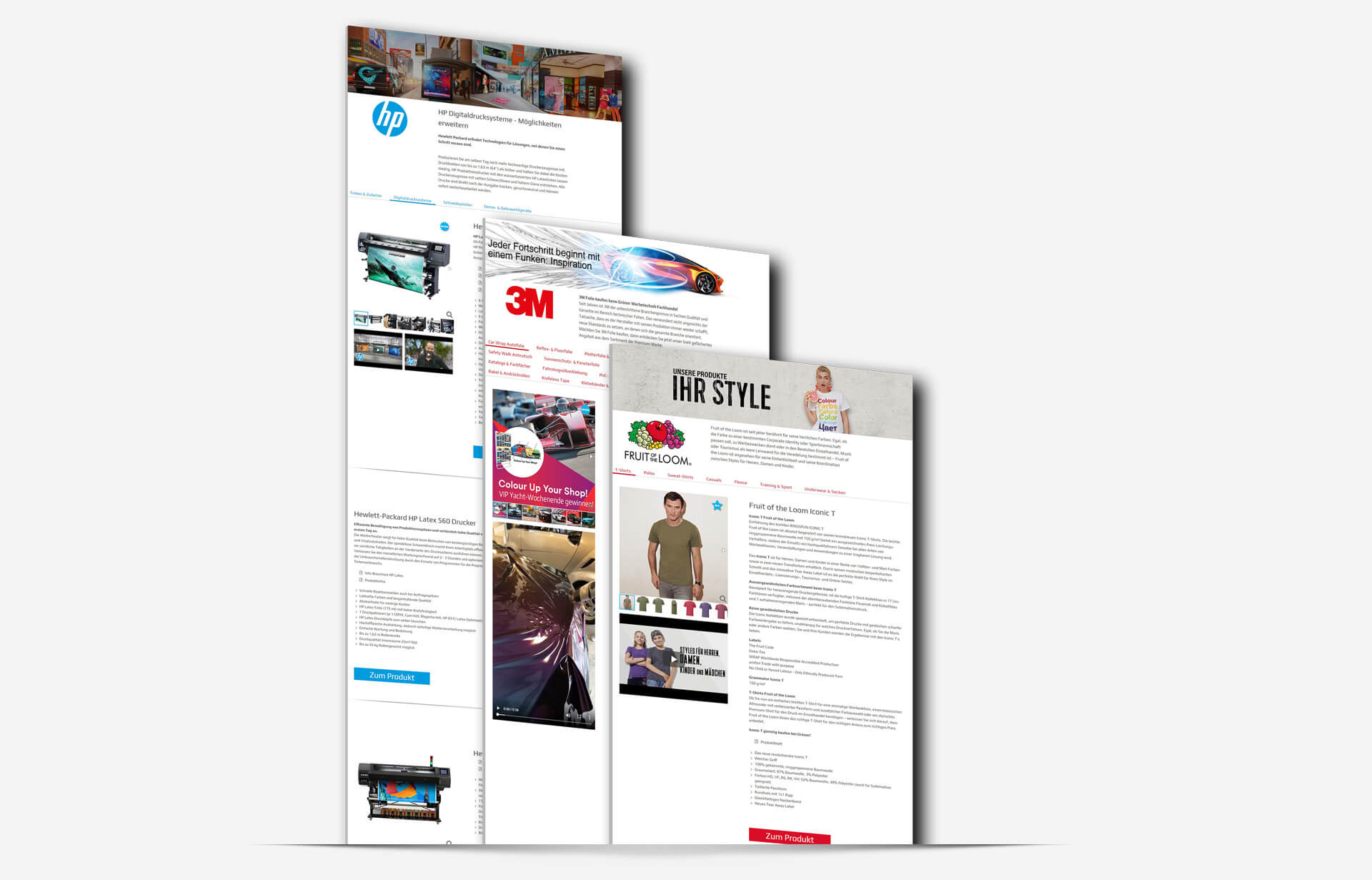
Important manufacturer brands receive a differentiated presentation of their products and contents - taking into account their individual appearance and appearance. The enrichment with editorial content is personalised according to brand-specific product groups and user groups.
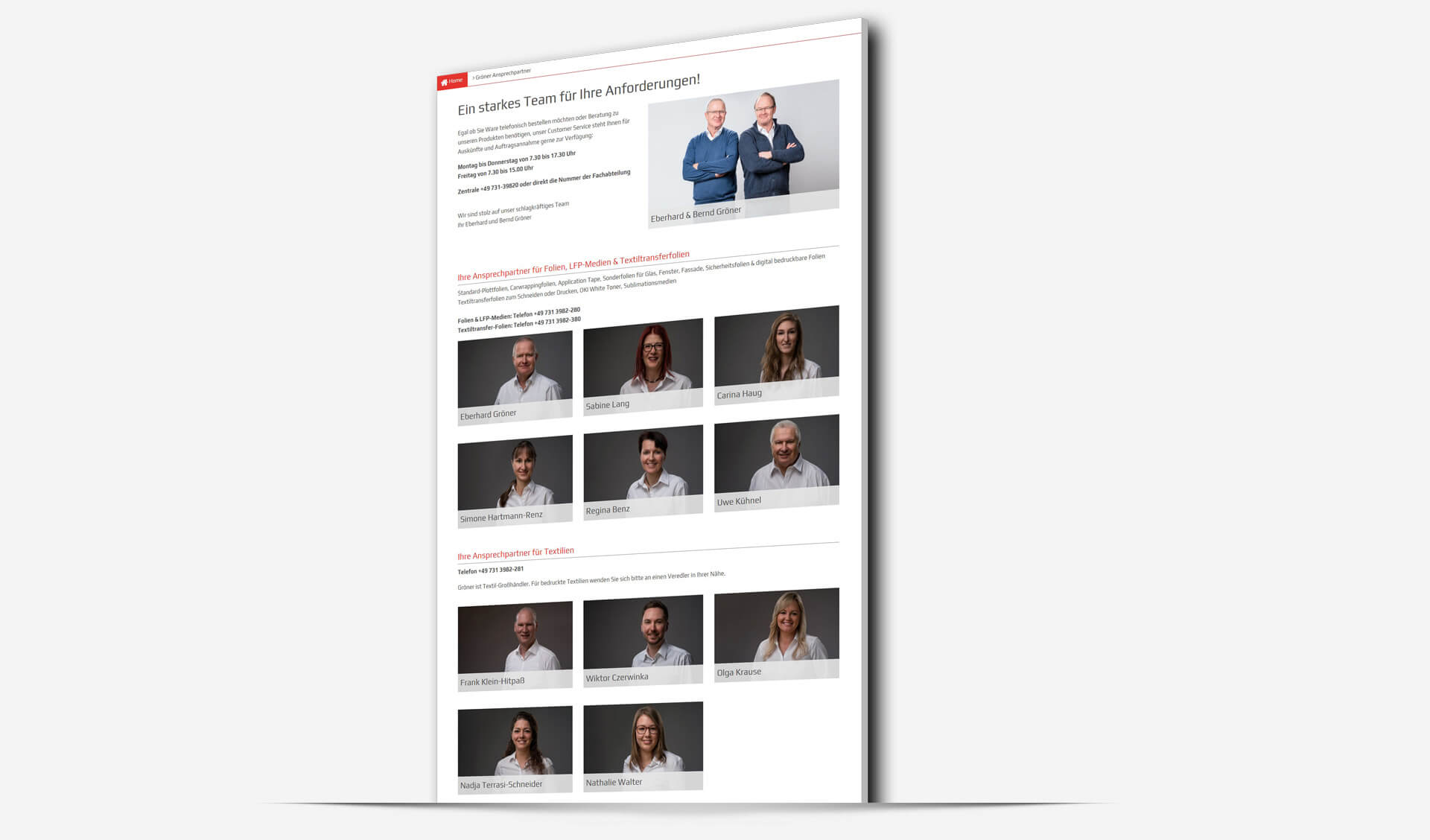
With the help of the CMS module integrated in BACKEND, extremely flexible pages can be designed structurally and layout-wise and filled with editorial content. The examples shown on this double page demonstrate only a small part of the possibilities.
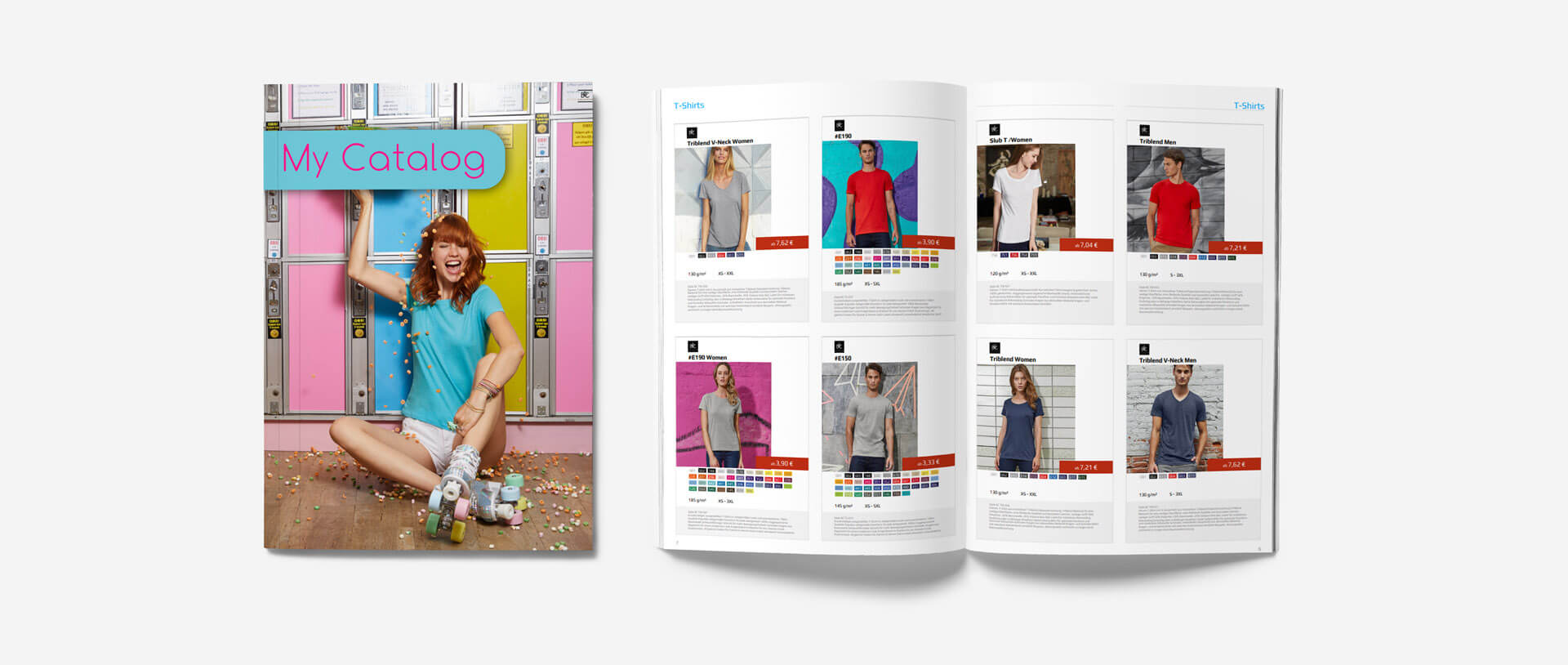
Although seasonally influenced, styles and their prices frequently change in the trade with textile articles during the course of the season. Therefore, current (print) catalogues and price lists are mostly in short supply. In addition, there is one aspect that is particularly important for textile finishers: the core business of these dealer clientele is to sell comprehensively finished outfits to companies and end customers. Gröner has come up with something special for textile finishers: A catalogue configurator with which individually designed, printable catalogues in PDF format can be created in the simplest way. All you need to use the catalogue generator is a web browser and a customer account on the Gröner B2B platform. Using drag&drop, a registered retailer selects from the current range of textiles which categories and styles he would like to offer to one of his end customers - for example sweatshirts, T-shirts and caps. In addition, the retailer uploads his own cover sheet for the catalogue that is currently being created. The retailer now determines the percentage surcharge on his purchase prices for the articles included in the catalogue. A hit list, which was created by filtering by category (e.g. "T-shirts"), brand grammage color, can also be derived as a catalog, for example for end customers of the retailer who already want to receive a specific offer. It couldn't be faster! My Catalog was realized on the basis of the ICONPARC Database Publishing solution. Within seconds, the configured catalogues can be output as web or printable PDF files and made available to a specific customer or any number of customers of a Gröner purchasing retailer. A catalogue with over 100,000 articles on 440 pages is generated in just two and a half minutes.
The BACKEND
Up to now we have mainly dealt with the specific FRONTEND of the Gröner B2B e-Commerce platform, but now we are going to focus on the BACKEND: This has a standardized look&feel as well as a comprehensive operating and authorization system, which is used by all ICONPARC customers. Functionally, many components are already integrated and "thought through" with practical functionality - for example about 300 assistants for different maintenance processes. On this basis, the customization is carried out with regard to the individual requirements of each ICONPARC customer.
On the following pages we introduce the BACKEND, which is the largest part of an B2B E-Commerce platform. All modules are seamlessly integrated, which also applies to the FRONTEND. This has the advantage that all solution components interact efficiently, effectively and free of media breaks.
which contain over 15,000 features, 300 assistants, 30 reports, 30 search systems, 20 detailed views and 45 job schedulers.
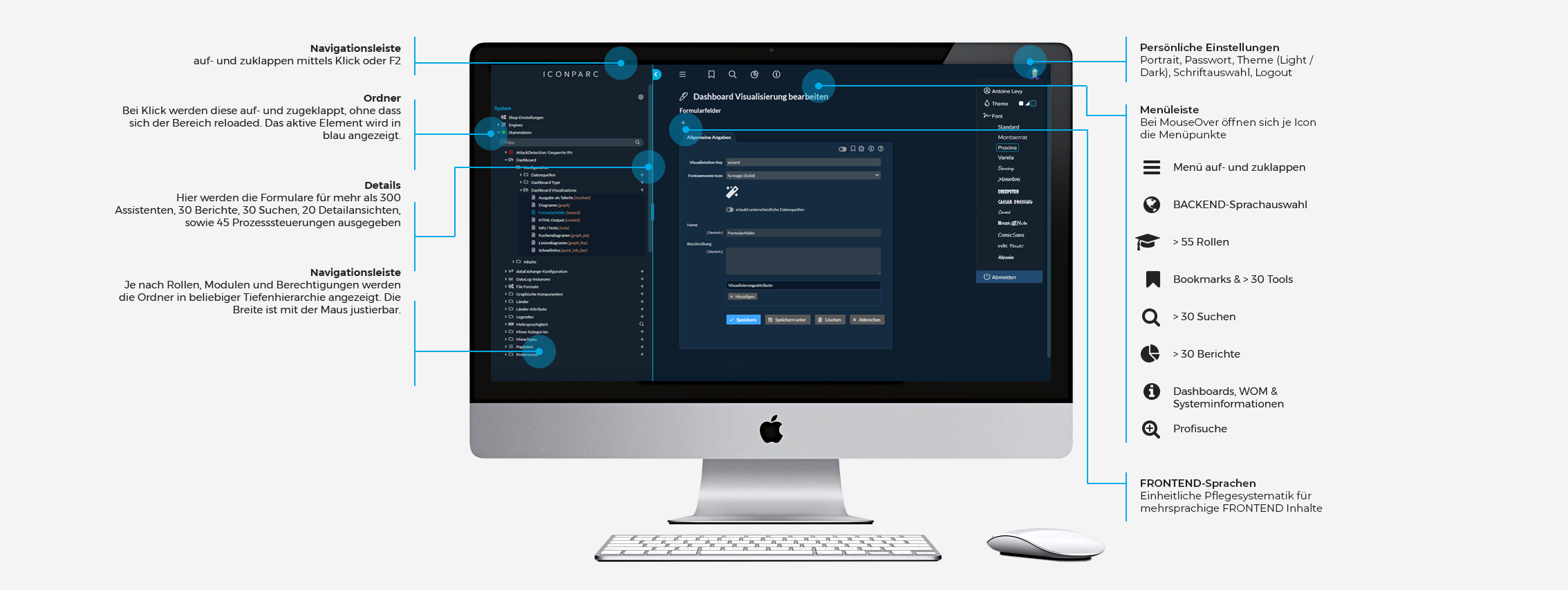

-
uniform, purely browser-based interface with clear structure and attractive design
-
maximum compatibility and security through SSL support and no ActiveX or client-side Java required
-
Easy handling due to easy to understand, consistently implemented operating system
-
sophisticated, modular design
-
clean encapsulation of reusable functionalities on library level, thus very well maintainable ...
-
Program code with excellent stability
-
All application and extension modules from the ICONPARC E-Business Suite are seamlessly integrated, as are individually modified or added features and interfaces.
-
multi-level authorization concept with finely granular access rights (top level = primary roles such as administrator, catalog manager, editor)
-
Support of multiple application scenarios and web presences
-
Multi-language capability for cross-country E-Business applications
-
Integrated development environment, including a repository for the underlying modelling level
-
Automated Job Schedulers with convenient settings of start times, time intervals and log files
Sales Team
The sales team usually takes orders by phone or in writing using an ERP client, which is usually tedious. This also prevents Sales Team employees from looking at their products and company through the eyes of their customers. In addition, the opportunity remains unused to introduce customers to the online channel with the help of internal sales. How can an employee get enthusiastic about E-Business FRONTEND when talking to customers if he does not use it himself and therefore hardly knows it?
In this way, your sales team usually has to cope with a high workload of repetitive requests requiring little advice - in the often unpopular ERP client, whose operation often causes additional frustration. Why not use FRONTEND, the E-Business already fully optimised for self-service by your customers, to take orders for the respective caller instead?

For this purpose ICONPARC has introduced the Customer Care Center module: This allows you to start a FRONTEND session as a substitute for the calling customer based on the BACKEND and the customer identification. Your sales team employee uses the E-Business FRONTEND with all customer-specific personalised contents, especially the individual prices and conditions.
This has several advantages: First of all, your office staff has become very familiar with the FRONTEND - and has learned to appreciate features such as quick search and filtering. The filling of the shopping basket and the subsequent check-out are also much easier than the corresponding operations in the ERP client. In other words: In FRONTEND everything goes faster and it is more fun. What's more, your employees will find it easier to understand the customer's view if they operate your digital channel with the customer's eyes. This constantly identifies potential for improvement. And your (still) offline customers still receive a detailed order confirmation via e-mail when they place their order via Customer Care Center. In this way, customers are gently introduced to the FRONTEND of your B2B E-Business solutions and may feel like trying it themselves next time in the FRONTEND. There your customers will also find the orders placed by telephone in the order history - very practical for easy re-ordering, and also to view the processing status at any time.
B2B E-Commerce
In order to use the Internet as a profitable sales channel, it is necessary to address interested parties and customers in a targeted manner, to make the selection of products as easy as possible for them, to present catalogue contents in a clear (and up-to-date!) manner, and finally to make the shopping process pleasant.
With the help of the versatile and individually supplementable comfort functionalities of the ICONPARC E-Commerce Module, you can turn occasional visitors into regular customers. Buyers are automatically kept up to date by e-mail on progress in order processing. Articles already purchased can be conveniently reordered from the order history of the respective customer. Via newsletter you draw the attention of customers and interested parties to special offers, services and promotions. These and other performance features contribute to the fact that your B2B E-Business platform meets with a high response.
So that you always have a full overview of your customers and their orders, extensive possibilities for the evaluation of all processes are integrated into the backend.
Catalog & PIM
In order to sell successfully on the Internet, attractiveness, clarity and correctness of the product data are just as important as with printed catalogues.
In contrast to the print sector, which sometimes has long catalogue runtimes, Internet customers expect product information and price quotations to always be up to date online. The provision of catalogue content as part of a website is usually associated with numerous additional challenges. Catalogue content is rarely available in a complete and structured form and cannot therefore be used directly for the Internet without additional preparation. In practice, a versatile and flexible tool is needed to provide high-quality product data for online catalogues: The Catalog & PIM module ensures that catalog content can be easily composed from various data sources. For example, basic article master data, performance characteristics and descriptions as well as price lists and illustrations can be imported step by step via different interfaces. The completely browser-based BACKEND offers all possibilities to subsequently edit, enrich or refine imported data. The image data is automatically optimized for web conformity, whether during import or direct maintenance. Product master data, descriptive features, price information, product group structures and much more can be conveniently and efficiently entered and edited. Use the easy-to-use import and administration options to ensure that your catalogue content is always up to date.
Search & Filter
The largest product range is of no use if customers do not find the desired products quickly. The Search & Filter module makes it easy for your clients:
With a combination of structured and full-text search across all product data as well as feature-based filtering and hit sorting, for example according to relevance.
With the Search & Filter module, searching becomes finding!
Direct search via the quick search field - or expert search with individual attributes such as designation, manufacturer, dimensions, features, etc.
Auto Suggest / Suggested hits
Already during the search input into the quick search field suitable articles, search terms, categories or manufacturers are suggested.
Filtering / After Search Navigation
Based on relevant product characteristics or article categories or merchandise categories
Support of synonyms and correction of typos (error-tolerant search), so that your customers will find articles even if they have mistyped, or use terms that do not appear in the article description.
So that your customers do not lose track of many hits, search results are sorted so that the most relevant hits are displayed first (relevance ranking). When determining relevance, the solution takes factors such as sales figures, call frequency, product groups, keywords, characteristics, etc. into account.
High-performance: Even with extensive product ranges, the search function determines suitable results in less than 200 ms. Even if the number of articles goes into the millions, the ICONPARC search system convinces with best performance: In a real ICONPARC project there are more than 50 million articles in the catalogue consolidated from many sources. However, search results are usually calculated in less than half a second.
The technical basis for the Search & Filter module is a so-called search index. This is a kind of table of contents for your product data, broken down by all relevant attributes. With the help of this data structure, products with desired properties can be determined within milliseconds. To generate the search index and to access it, we use the Apache Lucene search engine, which is seamlessly integrated into the ICONPARC E-Business Suite with numerous extensions.
With this solution architecture we relieve your SQL database (which can therefore process other queries faster) and deliver relevant search results largely without delay. Speed is a trump card in two respects: your customers love fast page access, and Google rewards you with a significantly better ranking.
CMS
The most successful way to keep visitors enthusiastic about your E-Business presence is to continuously revise and update the frontend content. While Google initially mainly evaluated page metadata such as keywords, the search engine now checks content for meaningfulness or topic-specific relevance based on context. On this basis, the classification in the ranking then also takes place.
That's why good content in the acquisition of new customers is now more sustainable than expensive SEM measures.
Content is King!
With the ICONPARC CMS module there are theoretically no limits. In practice, on the other hand, it is indispensable to design structures and the Look&Feel or operating systems uniformly throughout: This challenge is all the greater the more editors work on the content simultaneously, nationally or internationally. It is important that individual editors do not express their own design ideas. Rather, design and all general design aspects should be implemented in such a way that they are structurally and visually determined by your company's brand management, taking into account your corporate identity. Otherwise you run the risk that your customers will find a colourful patchwork carpet in the external image - here in the E-Business frontend - which will not do justice to your brand under any circumstances.
The ICONPARC CMS system automatically and conceptually ensures the uniform visualization of all frontend content. Permissible degrees of freedom can be finely granularly defined. Below we present some elements of the CMS module.
Snippets
All editorial content consists of individual content snippets. Simple snippets can represent a heading, an image, a video or a text block. More complex snippets, for example, allow for a "text-image-link" block. In addition to the numerous snippet types included in the standard scope, any other snippet types can be defined within the scope of customization.
Templates
By combining desired snippet types, templates for the actual editorial content are created by configuration, which can be conveniently managed in the backend of the solution with the help of the CMS template assistant. For example, it can be specified that certain snippet types must always be present in content that is derived from a certain template. The order of the applicable snippet types can also be specified, as can the permissibility of multiple occurrences of individual snippet types within the template.
Contributions
In the CMS Content Assistant, editorial contributions can be recorded and updated: These page components can be - if required personalized - placed in any number of places within a website. If a contribution is modified, this automatically affects all places where this contribution occurs. Within the scope of personalization, visibility can be limited, for example, by time or by assignment to specific visitor or customer groups.
Documents
Using the CMS Content Assistant, complete editorial pages can also be created: These documents can be used as link targets, for example for elements of a navigation menu, landing pages or newsletters. Editorial contributions can be placed on suitable page areas.
Example: Definition and design of a simple article template
The following example is intended to give an impression of how a coherent template definition - which can be combined with other elements - is created from many degrees of freedom. First, the order of the assigned (and thus allowed) snippet types has been set. Each selected snippet can be a mandatory field and must not remain empty. Headings must be written in capitals, in petrol and with bold 32-point font in the house font, left-justified. Only 2:1 or 1:3 size ratios are permitted for images. In order for the resolution to be sufficient for all end devices, images must be at least 2,000 pixels wide. After saving, images are automatically calculated in all required sizes and optimized for display on desktop PCs, tablets and smartphones. Buttons always receive a caption in the house font in capitals and with 20 point size. The frame is 1 pixel strong in black. With MouseOver the button colors itself in dark blue with white writing.
The highlight: no editor can avoid the template definition, i.e. it is not possible to change or overwrite the design. Your brand manager will take this up with relief, because in this way the promising combination of
Middleware
If you use a standard product as part of a B2B e-Business digital strategy, this usually leads to an isolated solution. This stands alone or is not sufficiently integrated into the existing, mostly complex IT system landscape of your company. Cross-process process control is not possible in this way. Here is a simple example: Your ERP system contains many basic master data on customers, their employees, invoice and delivery addresses as well as individual prices and conditions. Without an automated, bi-directional link to your E-Business solution, the master data is maintained in several places, so that deviations and contradictions in reality are the unavoidable consequence.
Catalogues, product groups, features and articles
This data is also already available, mostly in the ERP or PIM system. Here it is also of decisive importance that the data is automatically transferred to the E-Business platform and processed there. Your products can be placed most effectively on the market via the digital sales channel!
Customer-specific assortments, prices, discounts, delivery times and availabilities
The added value of an E-Business business solution for your customers results in particular from the provision of this information in real time.
What about orders, delivery notes and invoices?
You can only count on a high level of acceptance for your solution if all the data already mentioned is kept up-to-date on the E-Business platform. In this sense, it is consistent to automatically transfer the online orders of your customers to the ERP system. This in turn provides delivery notes and invoices, which can be downloaded by the customers in the E-Business frontend. Compared to manual activities or process steps, Digital Customer Services scale excellently - with the lowest error rate at the same time.
Solutions implemented by ICONPARC
for example, retrieve customer-specific prices from the ERP system in real time, or calculate them "on-the-fly" at all points where the frontend requires prices.
A small calculation example illustrates the requirements on your system landscape: In practice, hundreds (sometimes even thousands) of customers will be online simultaneously and carry out search and filter actions on the E-Business platform. If only 200 customers retrieve hit lists with 40 products at a time, then 8,000 prices must already be determined - with as little delay as possible. ERP systems often find it difficult to cope with such quantity structures and the associated burden. However, because these customer-specific data are absolutely critical to success, we have developed numerous procedures, caching systems and algorithms over the past 24 years to provide high-performance assortments, products, availability, prices and conditions in the E-Business solution.
A "side effect" of successful digitization: the more you sell online, the more time your sales force gains to win new customers and open up new markets.
The selection of supplementary modules is growing year after year - and the wishes and needs of our customers inspire us to constantly develop new functionalities. Of course, every out-of-the-box feature can be individually adapted. This flexibility is particularly possible because our framework has been structurally based on a multi-layer architecture right from the start.
This allows us to add further modules to your platform at any time - even if customized as extensively as you wish.
You decide what you need and when. And that's not all: Customization allows you to selectively overwrite the functionality of all modules in our library. Compatibility with our standards is maintained at all times - updates within the scope of maintenance can continue to be carried out.
We always have our finger on the pulse, constantly refining existing modules and continuously and highly agilely expanding our range of solutions. Each of the modules listed here is used productively in LIVE environments.
B2B E-Business Solutions from ICONPARC - Individual. Resilient. Enduring.
And there are more and more. Because digital transformation is a process - constantly in motion and undergoing change.
Ticket System & Documentation
We involve our customers closely in the development process of their solution. To ensure that nothing is lost from the constant exchange between you and us, we use a ticket system, which is structured like a discussion forum or chat program: Each aspect of the current project phase receives one or more threads, which reflect the entire process of coordination between all participants on your and our side. The ICONPARC TicketSystem has its own FRONTEND, but can also be completely operated via e-mail.
PHASE III - OPERATION AND FURTHER EXPANSION
The live operation of B2B solutions as well as the further expansion and optimization of the
Development methodology

One Size fits all? Every fashion fan knows that only the right size of a garment is really fun. The situation is similar in software development: challenges at different levels can best be mastered with the appropriate development methods. In addition to the individual levels of the multi-layer architecture of our technology (each with a standardized scope of services), the project business (with a customer-specific, individualized approach) in particular requires a different approach to ensure the best results. In this section, we introduce you to the development methods we use - and explain why which methodology is particularly suitable for the respective task.
The figure shows how the optimum development methodology can be derived from the degree of clarity of the requirements on the one hand and the technical implementation on the other. In this so-called Stacey Matrix, all methods relevant to us are presented - these are explained in the following sections. As a general rule, the more unclear the requirements and implementation paths are, the better agile methods are suited.
Design Thinking
Equally unclear requirements and implementation methods mean that we operate in an unstructured environment. What sounds frightening to computer scientists is a common scenario for creative people and design phases. It is only gradually that new order emerges from the initial chaos. With the help of Design Thinking, FRONTENDs in particular can be created that offer the best user experience (UX := User Experience) and make it available to users on all common end devices - using Full Responsive Design. Once a FRONTEND has been designed using Photoshop, we develop a prototype in HTML/CSS/JS on this basis, which makes the operating concept tangible and is refined iteratively in dialogue with the customer.
Waterfall
Requirements and technical implementation are relatively clear: This is about processes - whether in FRONTEND or BACKEND - which have already been described in a structured way in a technical specification. Proven paths are followed during implementation, so that few surprises are to be expected.
CIP - Continuous Improvement Process
In small steps, continuous improvements are achieved within a clearly defined framework. This approach is particularly suitable for optimizing the application server level (IPACT), where downward compatibility plays a decisive role.
Kanban
Now we move to the Library Layer, which is by far the largest part of the ICONPARC B2B E-Business Framework. This is about optimizing processing times and quickly identifying bottlenecks. In particular, we want to prevent several developers from working hand in hand at the same point within the large library, so that they do not get into each other's enclosures or can work on as much space as possible in parallel. Since it can never be 100% ruled out that different developers (with different objectives) will work at one and the same place in the library, another method, which can be easily combined with the Kanban approach, helps to decouple parallel work from each other: complex extensions, which potentially have many repercussions for other places in the code, can be outsourced to a so-called branch. There, functionalities can be built and tested in peace - even by several developers - before these massive changes are finally merged back into the main development path (trunk).
Scrum
In perhaps the most popular agile method, the customer is hardly involved. Rather, it is an integrative process between developers. The B2B E-Business Framework, which ICONPARC has been developing for about 24 years, is subject to a process of constant optimization and expansion, without it being completely clear where the journey is heading. A new intermediate result is created with each step: On the basis of these intermediate results, missing requirements and technical solutions can be found more efficiently than through an abstract clarification phase. At Scrum, planning develops iteratively and incrementally. The empirical improvement is based on three pillars:
- Transparency: The progress of a project is described regularly and transparently for all participants.
- Review: Project results and functionalities are regularly delivered and evaluated.
- Adjustment: Requirements for the project, plans and procedures are adjusted continuously and in detail. Using Scrum does not reduce the complexity of the task. Through structuring in the form of smaller and less complex increments, the complexity associated with the given task can be reduced to a minimum.
TestBots

In addition to the usual tests by developers and the quality management team, we use extensively automated tests with the help of so-called TestBots: These help us to check more than 15,000 features in the 500 dialogue assistants, 50 reports, 20 search classifications, and 25 detailed views of the BACKEND with regard to errors. This is done on all our systems for development, staging and live operation. If an error is found, the TestBot reports it with extensive context information to a quality management employee. Since all customers largely use framework components and the same library, a bugfix is quickly created for a detected error and adjusted to all systems.
Permanent testing - whether manual or automated - makes a significant contribution to the robustness of our solutions.
Maximum agility
through a tool-supported and largely automated software delivery process (Continuous Delivery & Deployment). Every week we update all live systems after the corresponding update packages have been tested in staging environments. ICONPARC customers receive an overview of all installed updates via the BACKEND - including graphical visualization of the time course. Numerous other metrics for the respective live system are also presented in an appealing way.
Modernization
It is not only the viewing habits of users that have changed significantly in recent years as a result of increasing mobile surfing on smartphones and tablets. The technical requirements are also growing and changing constantly, e.g. due to new web browsers on PCs and mobile devices (with support for newer versions of HTML/CSS/JS), the changed specifications of search engines, and current security requirements. The modernization of our technology is a continuous process, which technically means that the backbone of the software - the technology base or framework - must be continuously improved and further developed. In particular, continuous refactoring helps to ensure that existing structures are scrutinized and optimized. This creates a background noise of updates, which is of course already covered by the monthly update fee. As a result, your ICONPARC platform is technologically fresh even after many years of productive use!
Project progress
A successful platform will be extended and improved again and again as an operator, because standstill in the implementation is already a step backwards. The degree of customer orientation, individualisation and comfort achieved in FRONTEND can be optimised again and again on the basis of user feedback, own findings and new technical possibilities. It often happens that existing processes are adapted to modern viewing habits (e.g. autocompletion makes suggestions, optical redesign). In addition, new ideas emerge in dialogue with your customers to improve individual features or add extensions. Project development takes place technically in stages or phases: After the GoLive is before the GoLive!
Bottom line
From a technical point of view, modernization and project development are intertwined because (partly highly individualized) project functionalities are based on centralized functions and modules from the standardized B2B E-Business framework or are interlocked with them. ICONPARC's special approach ensures that both development processes interact continuously.
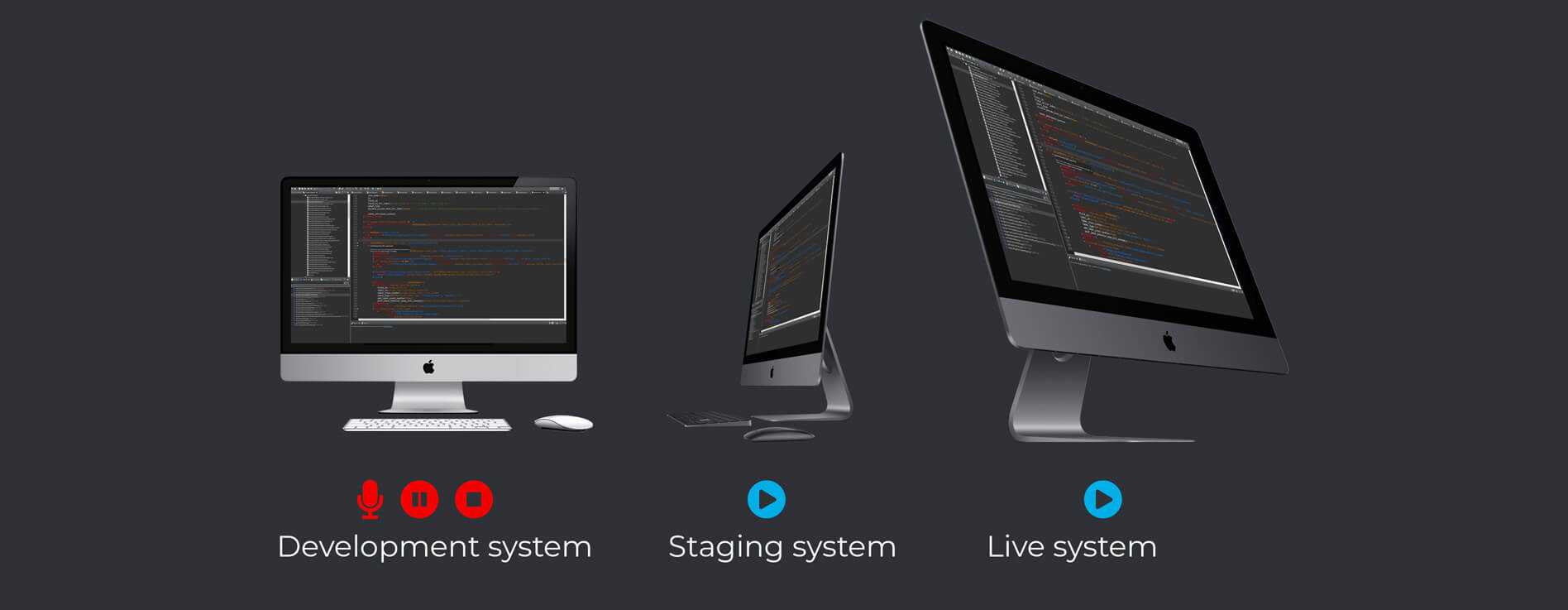
The procedure
When developing or revising a module or feature, the developer begins with its coding. The coding can be paused at any time if several people are working in parallel. As soon as the development work is done, the system automatically identifies all changes and saves them as a so-called software feature. This software feature bundles all related code changes, graphics, database adjustments, etc. into one package. In order to use the software feature on a staging or live system, the developer only has to perform a few steps in the migration assistant: All the necessary changes are then applied to the target system - precisely with the necessary sub-steps and in the correct order.
This system is extremely efficient and robust.
Database with metamodel

New application processes are created in an ongoing dialogue with our customers. Development initially takes place on the Development System. It happens again and again that (also) the data model has to be changed or extended. Each of our databases has a metamodel and is therefore self-describing. Using the tools for the metamodel, we create new tables, relations (foreign keys) and indices. Existing elements can be modified. The data model elements created or modified in this way are to be transferred to the staging system - and later to the live system - without interrupting operations.

For this purpose, exactly the same steps that were initially performed on the development system are now reproduced in the same sequence on the staging system (and later on the live system) during ongoing operation - automated, and thus highly efficient and error-free.

Using our self-describing databases and development tools operating at metamodel level, migrations are fast and error-free. We can also easily synchronize content across systems, as we know and distinguish between identity and compatibility attributes. Of course, larger migrations can also be bundled - for example at night, so that performance is not impaired during the day.
What do our customers get out of it?
Maximum security, agility and flexibility for rapid growth
Terraforming

The goal of terraforming is to transform a planet into a habitable earth-like environment. Through the transformation by means of future technologies, human life is to be made possible there. Perhaps you know the principle from the film Total Recall with Arnold Schwarzenegger?
We were inspired by it to comprehensively revise our basic technology year after year and to keep it young. By using refactoring techniques, we achieve exactly this result - not only on development systems, but also for all our customer solutions.
We differentiate between ...
Manual Refactoring
We optimize and clean our program code day after day. The goal is to always get a bit better in order to reduce the effort for troubleshooting and functional enhancements. We improve readability and comprehensibility for all employees involved in coding. The quality management team assigns tasks to our developers, who all contribute to the optimization of the code quality.
Automated refactoring
extends to all systems, whether development, staging or live environment. What is important here is the ability to allow such changes to flow in parallel with the ongoing stream of software updates - free of conflicts with what developers are currently coding. This is made possible by automated terraforming processes, which run time-controlled every weekend - or at night - across all code points in all affected systems in order to make adjustments.
Solutions from ICONPARC are durable and always stay young.